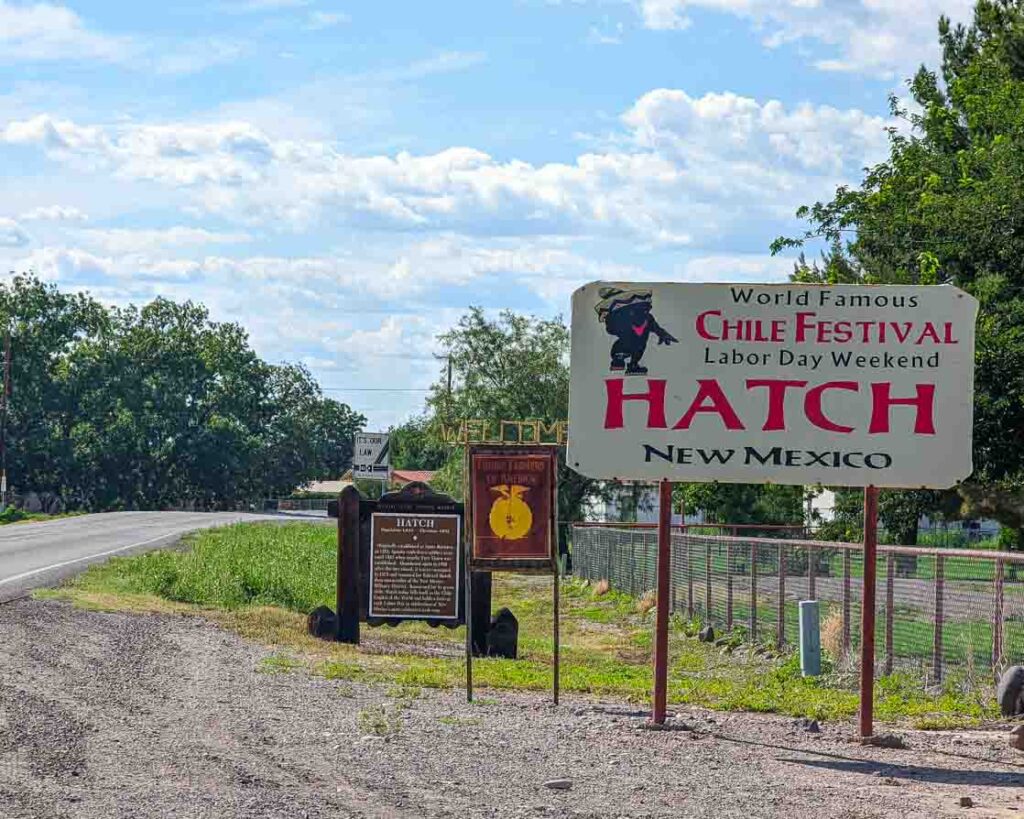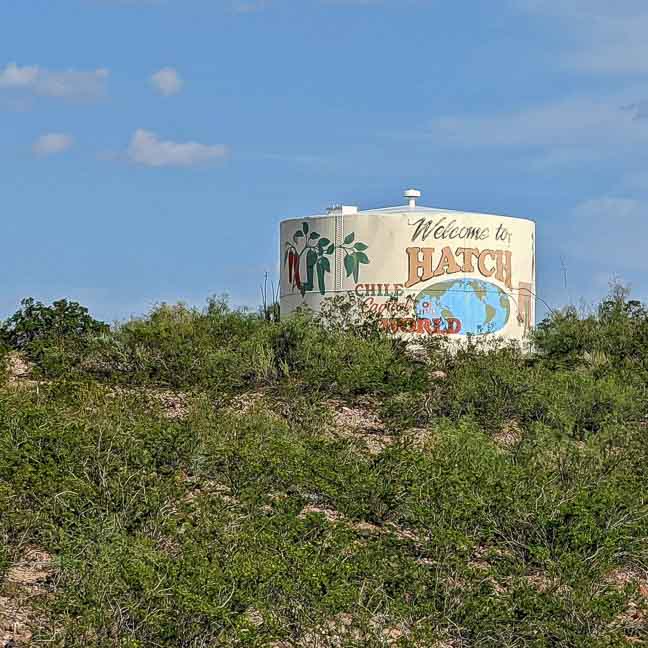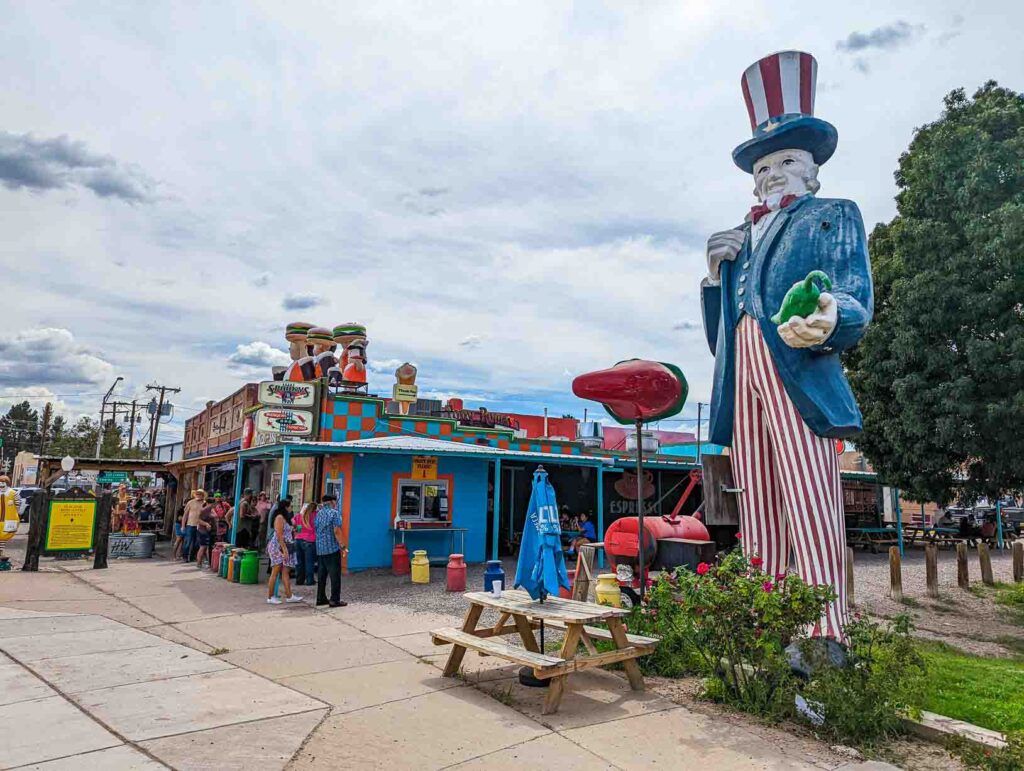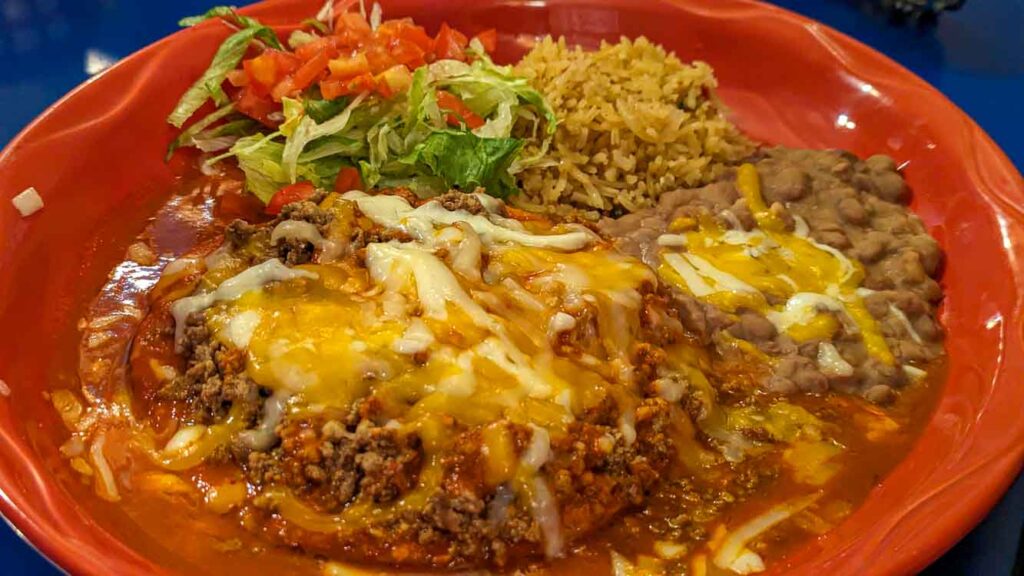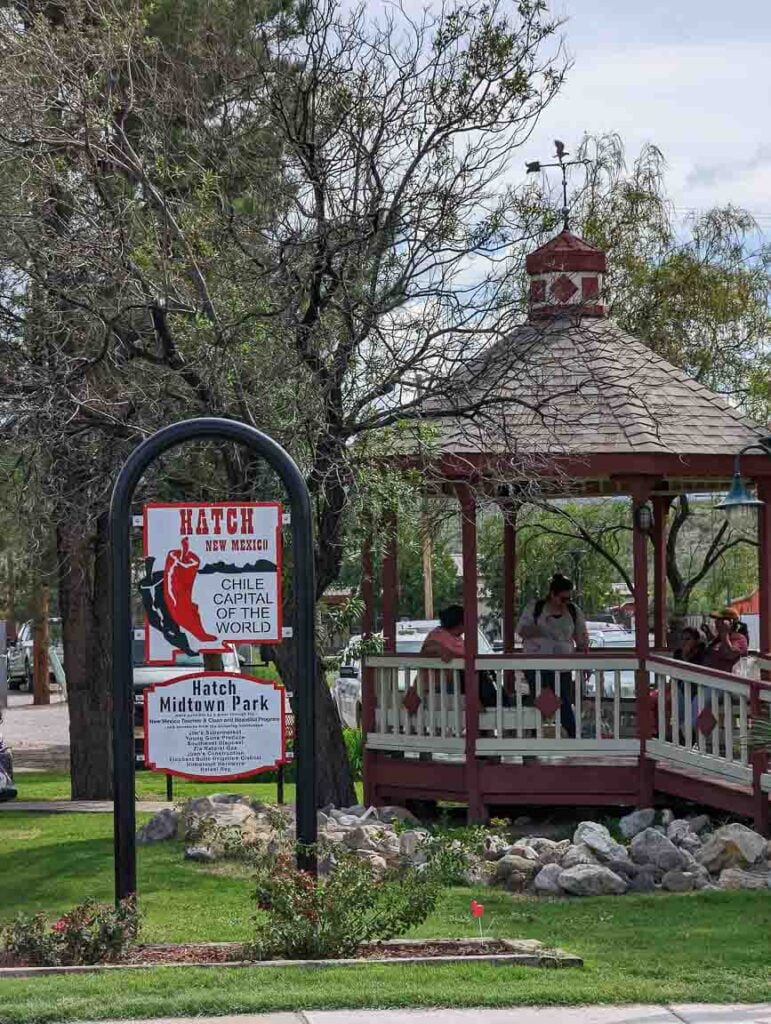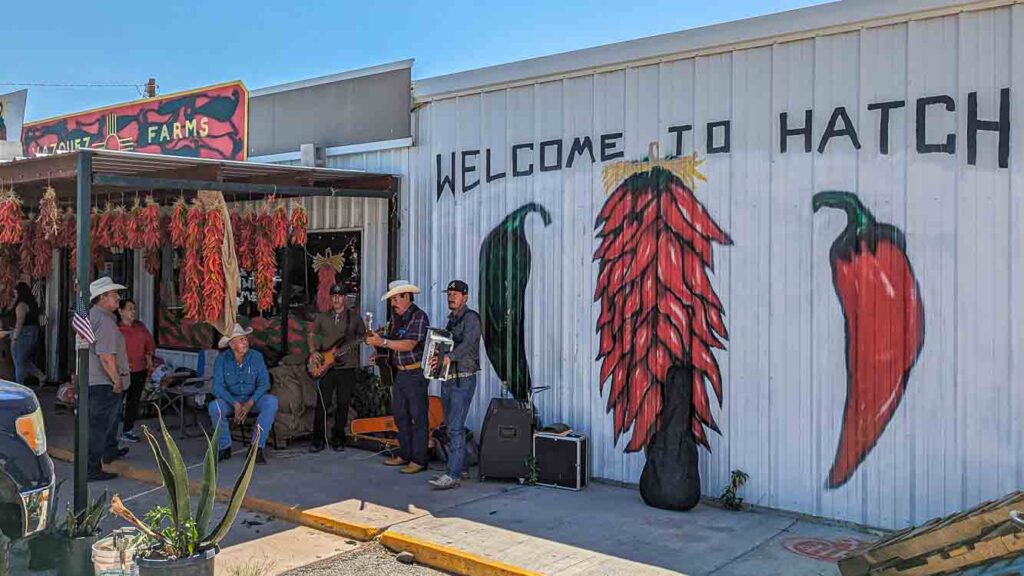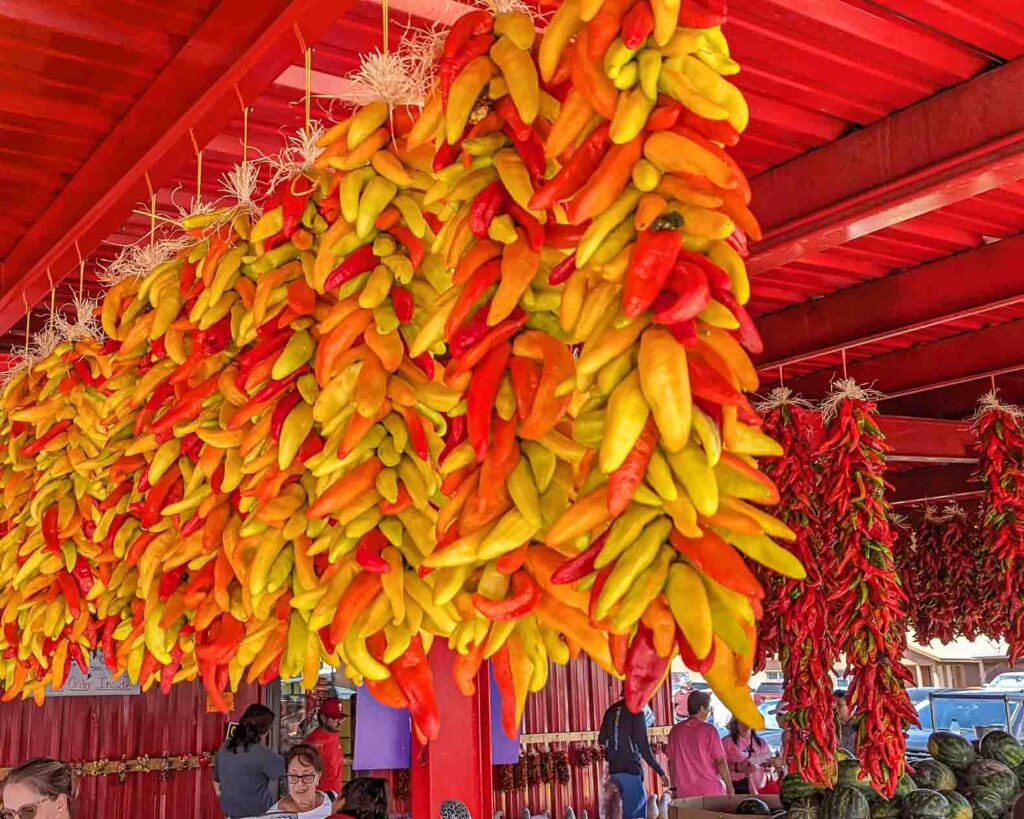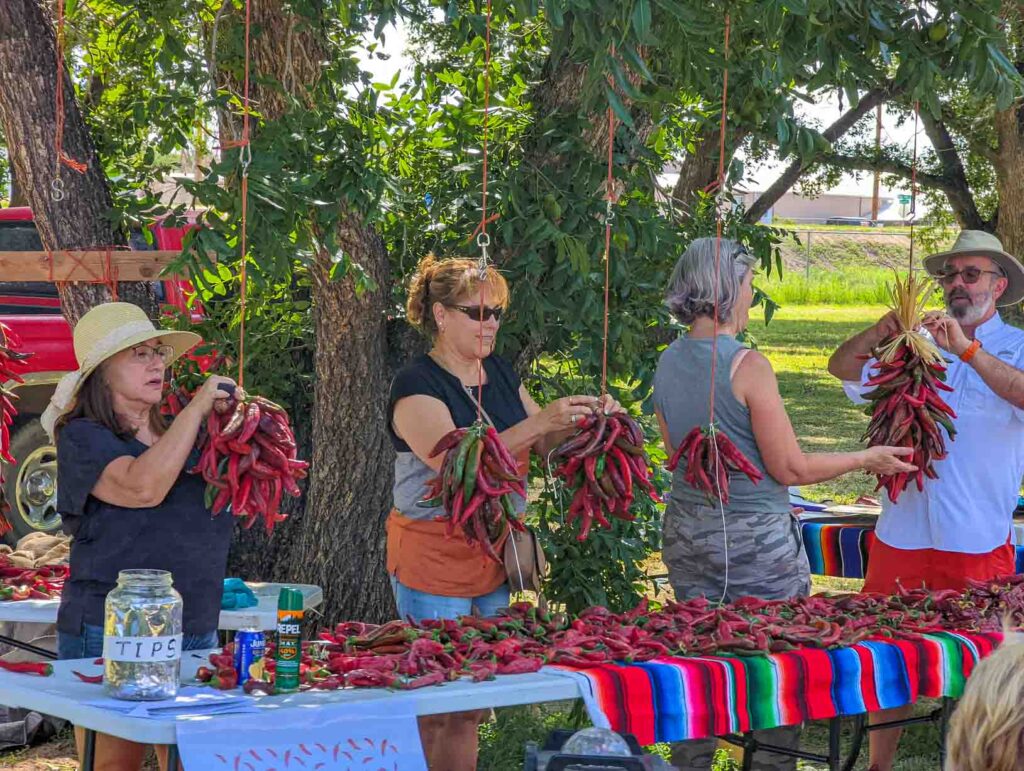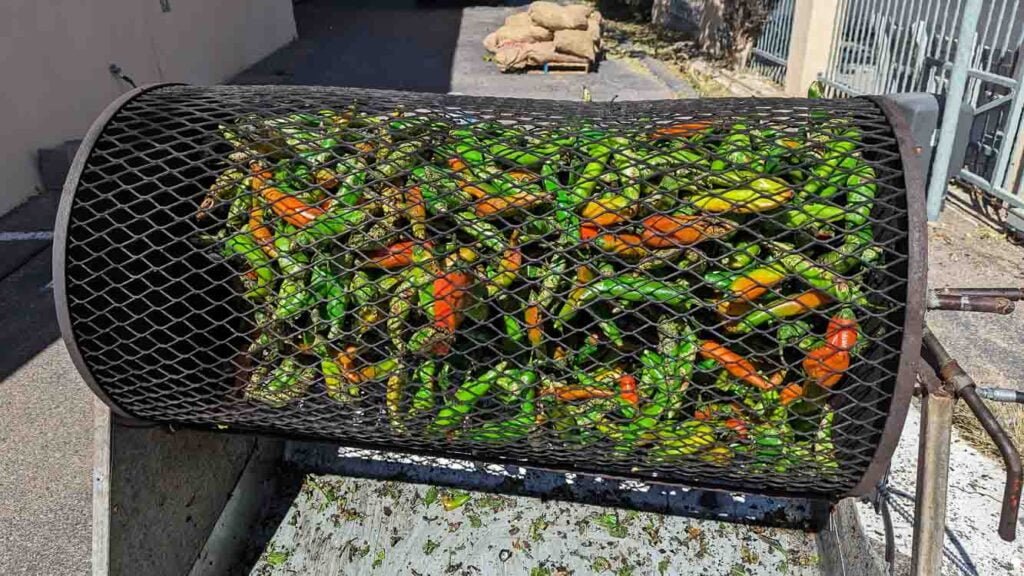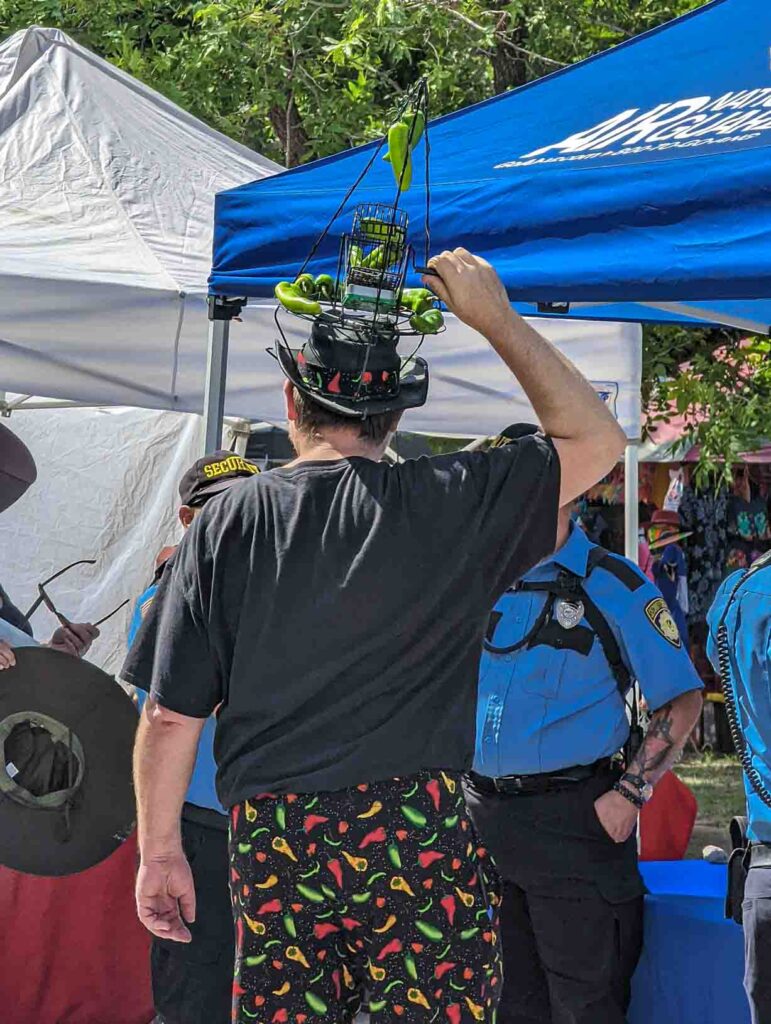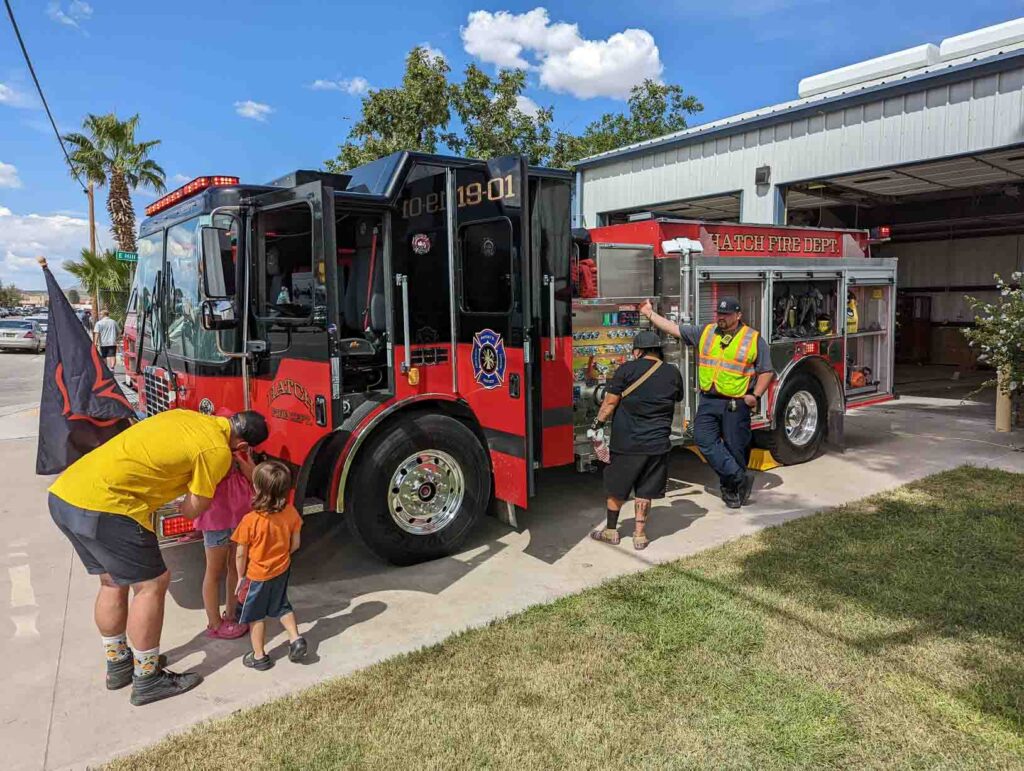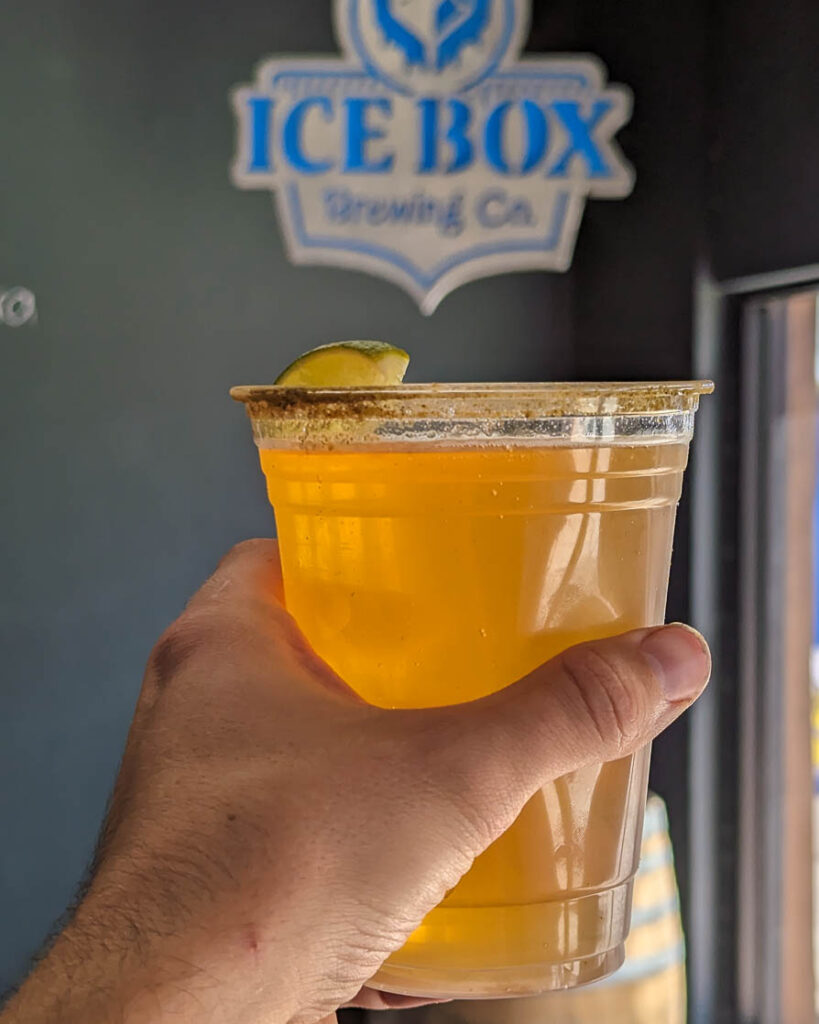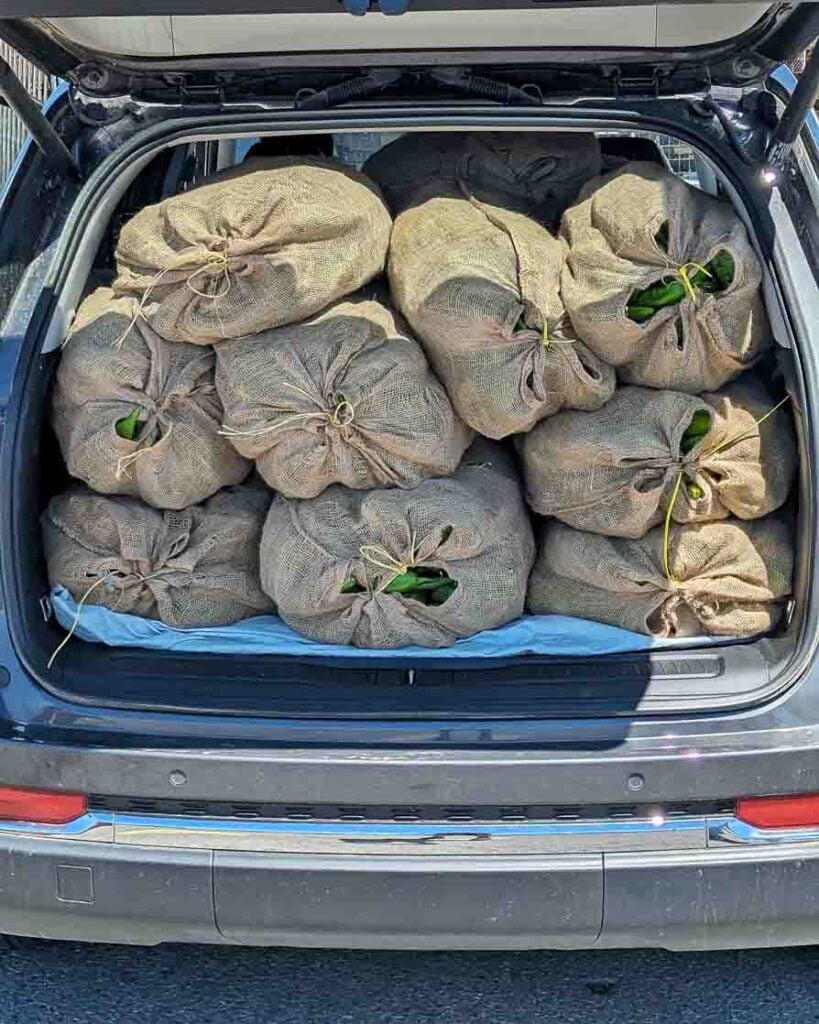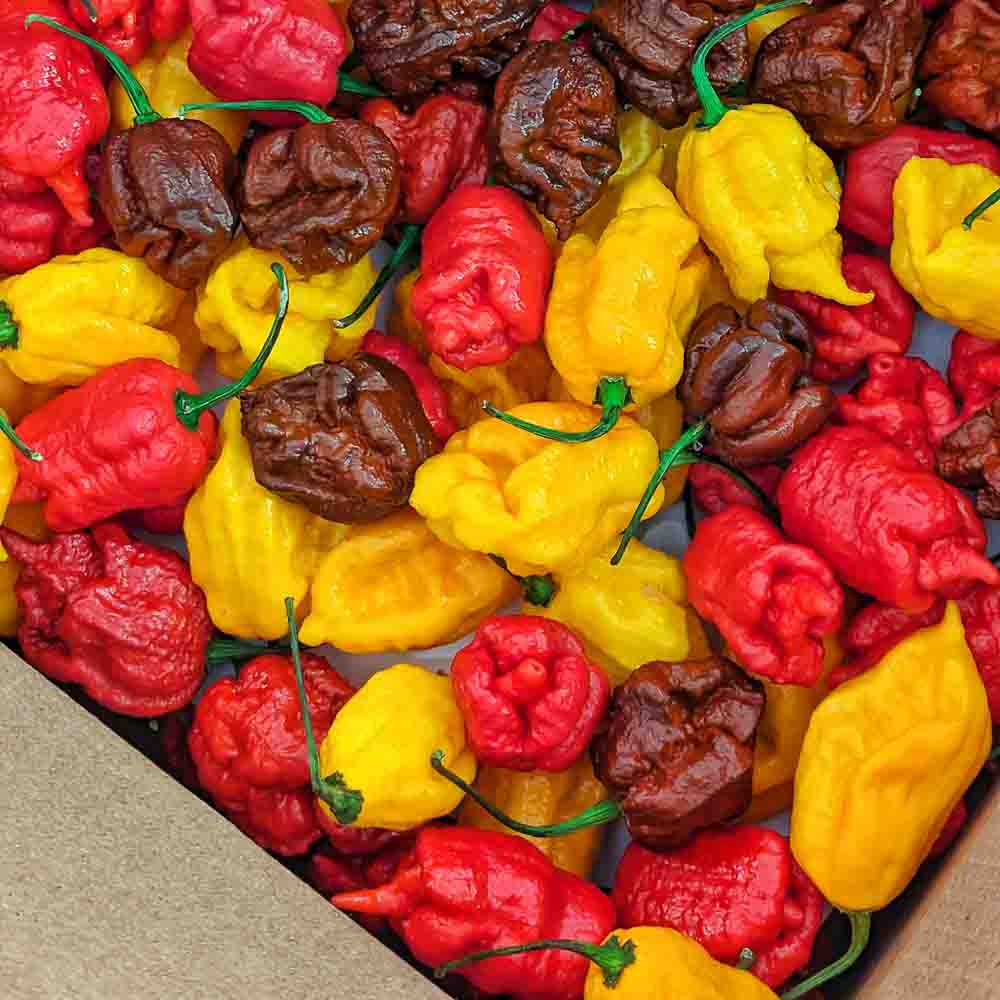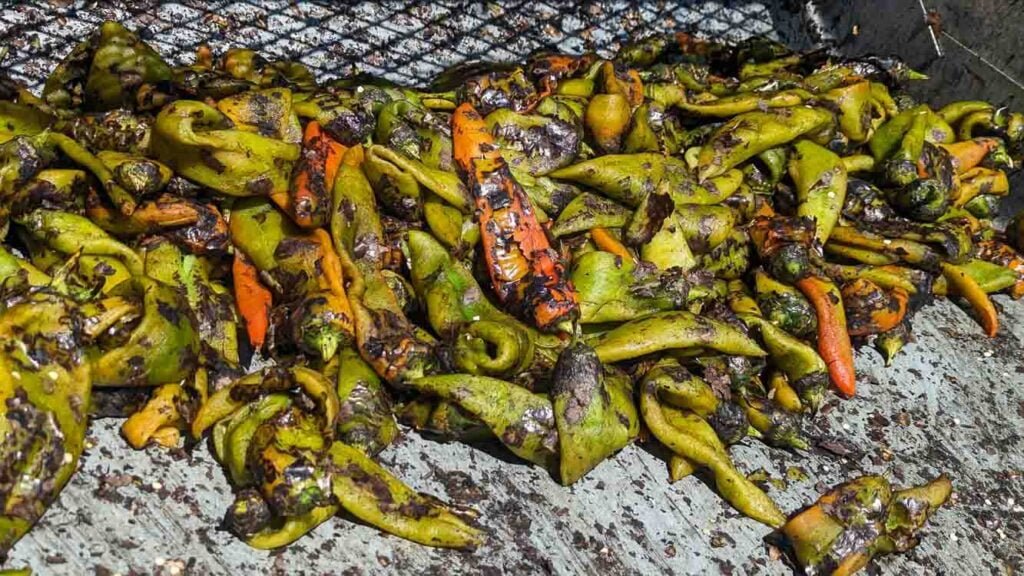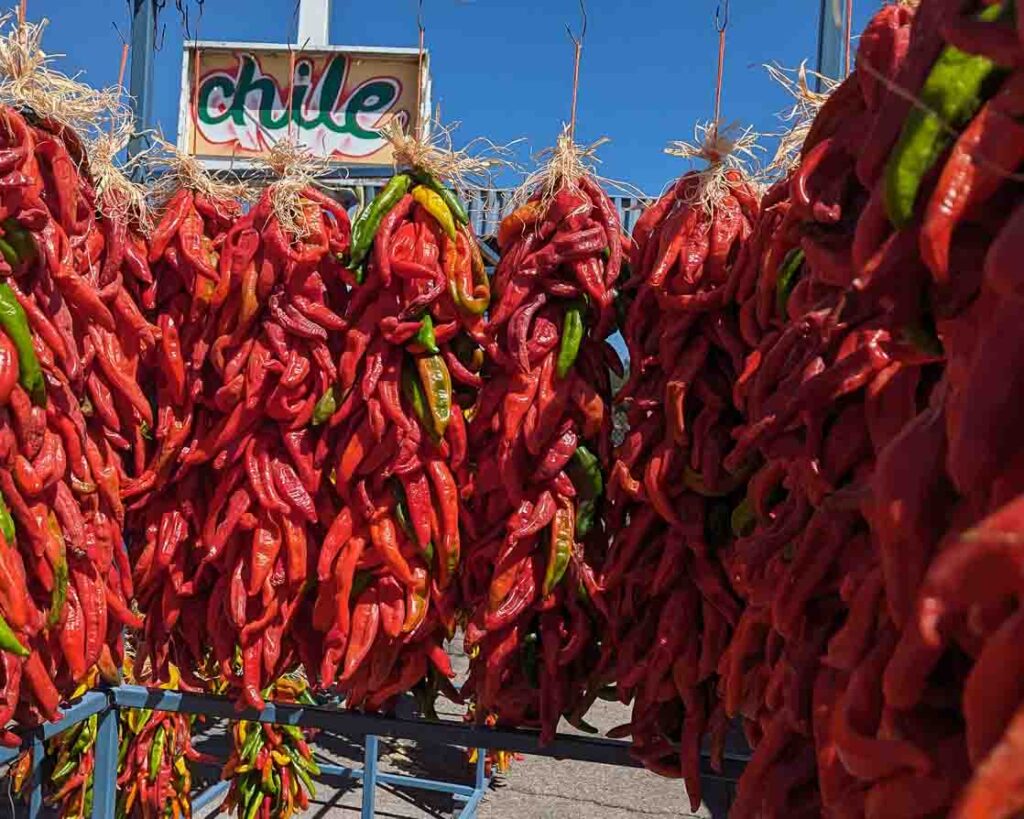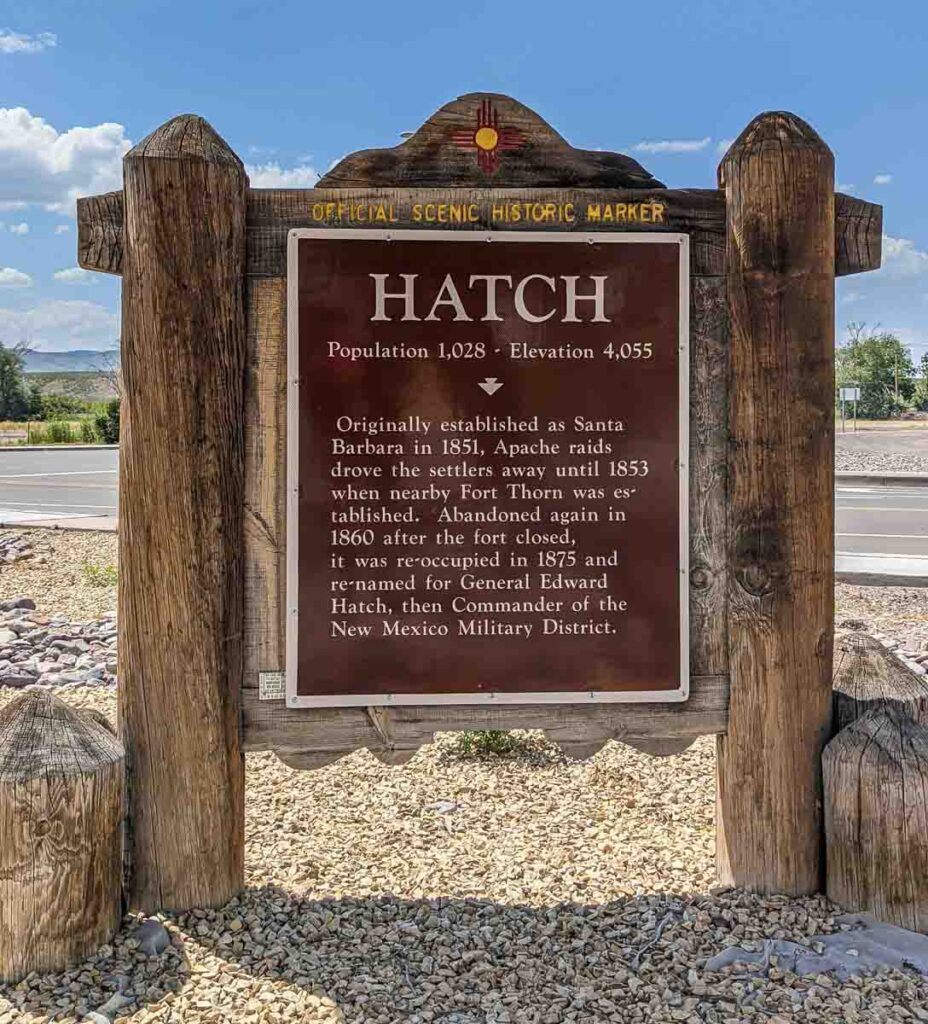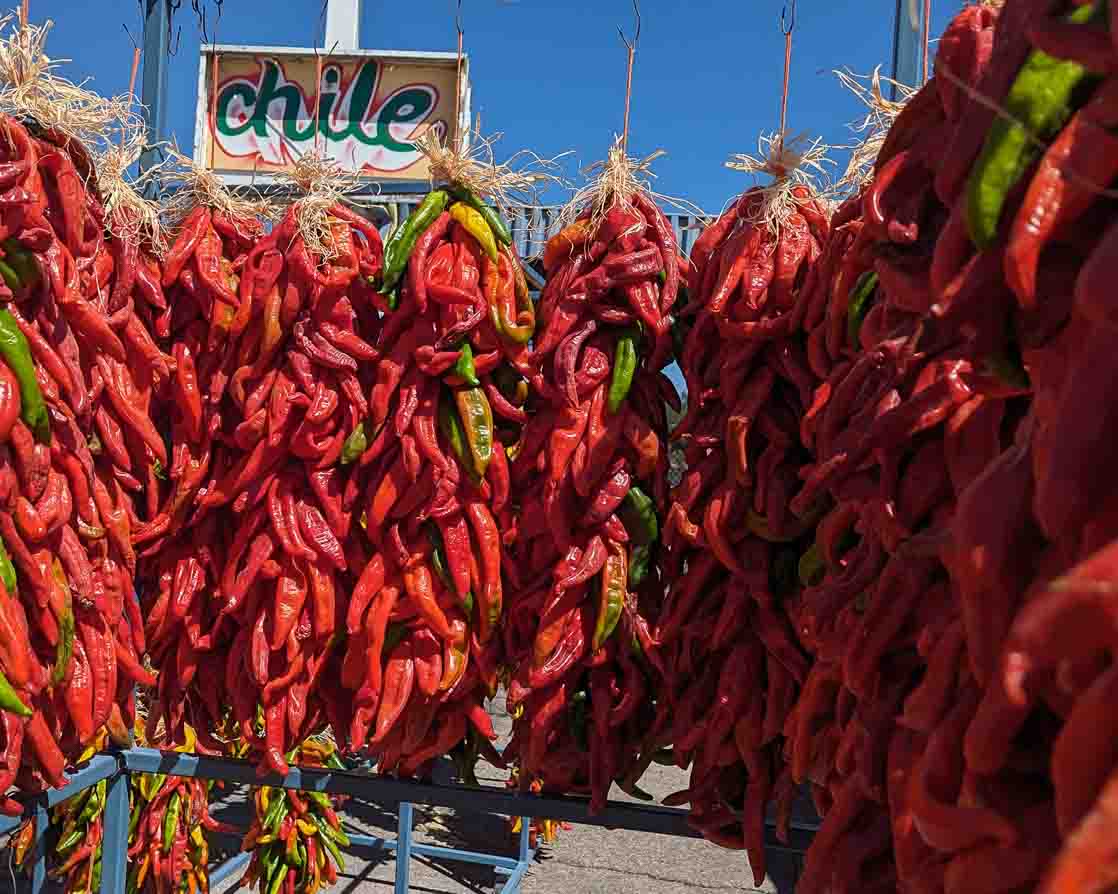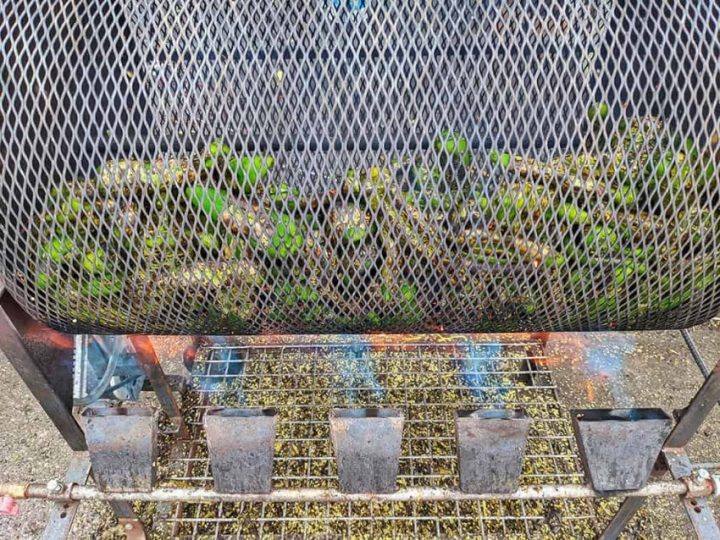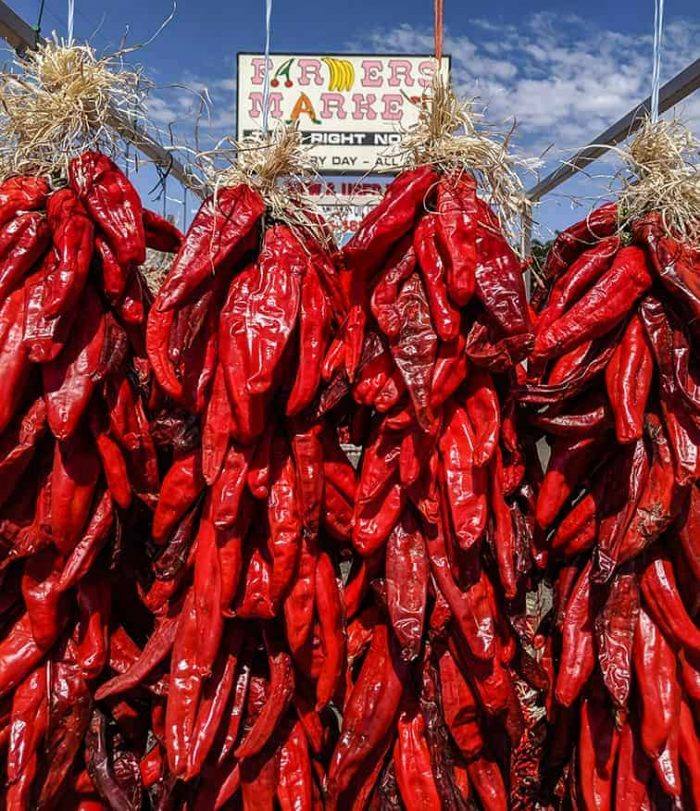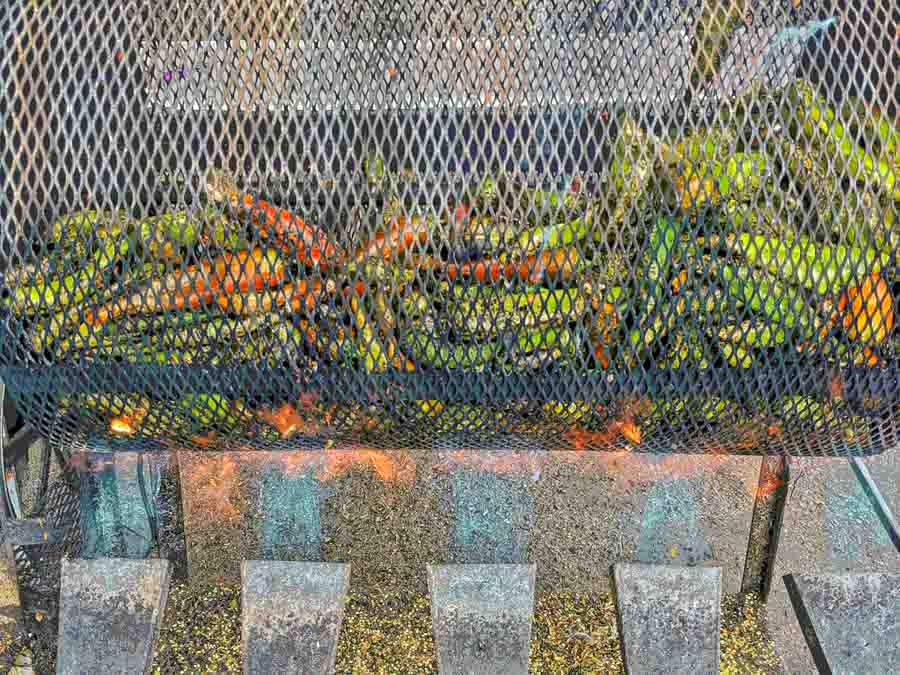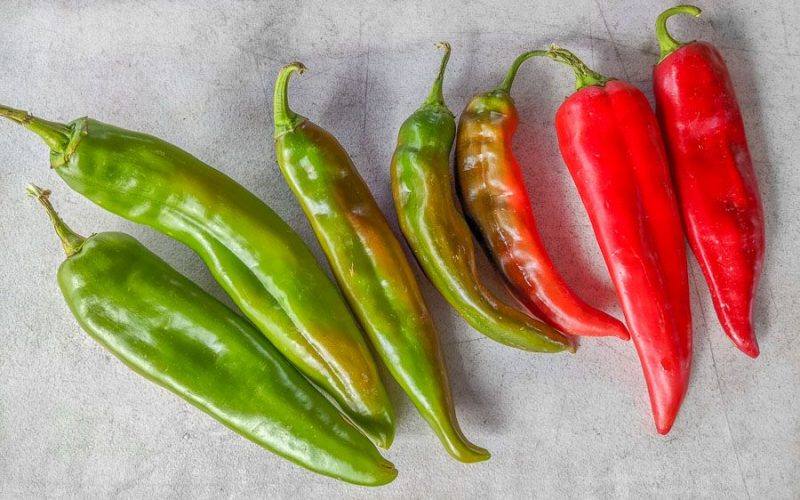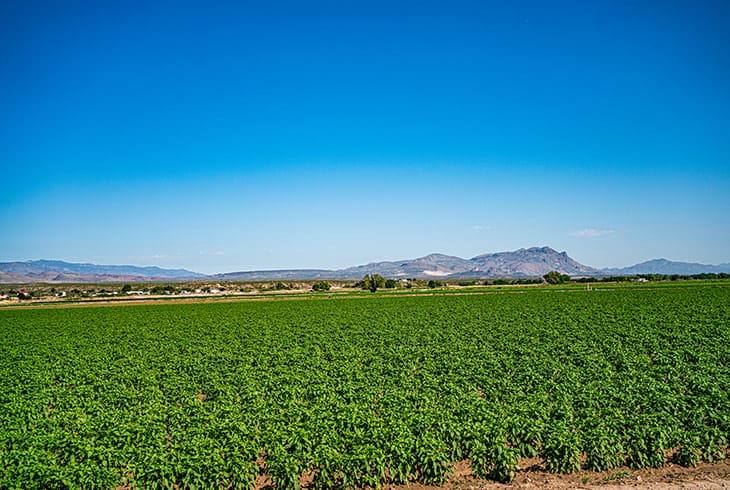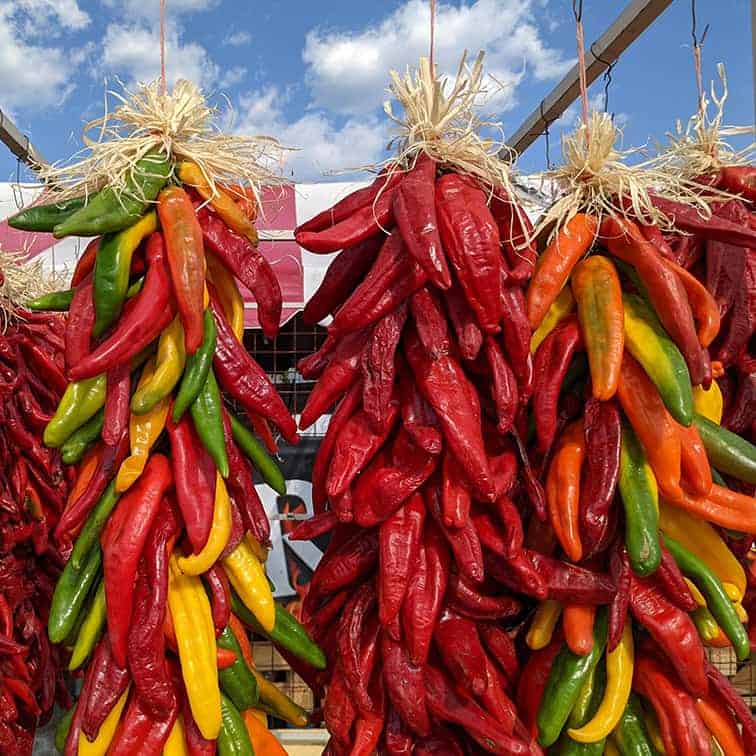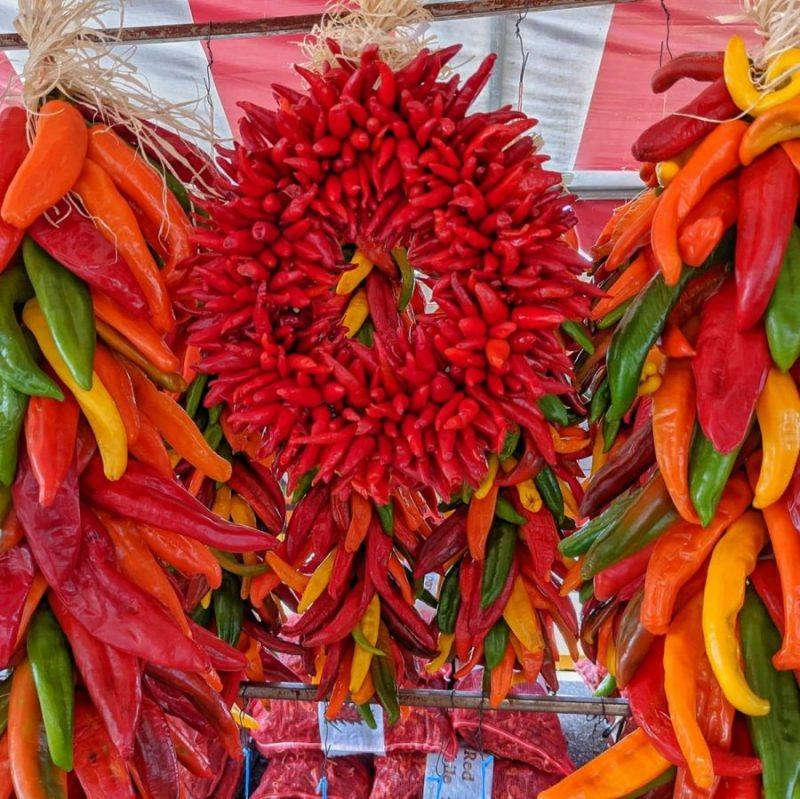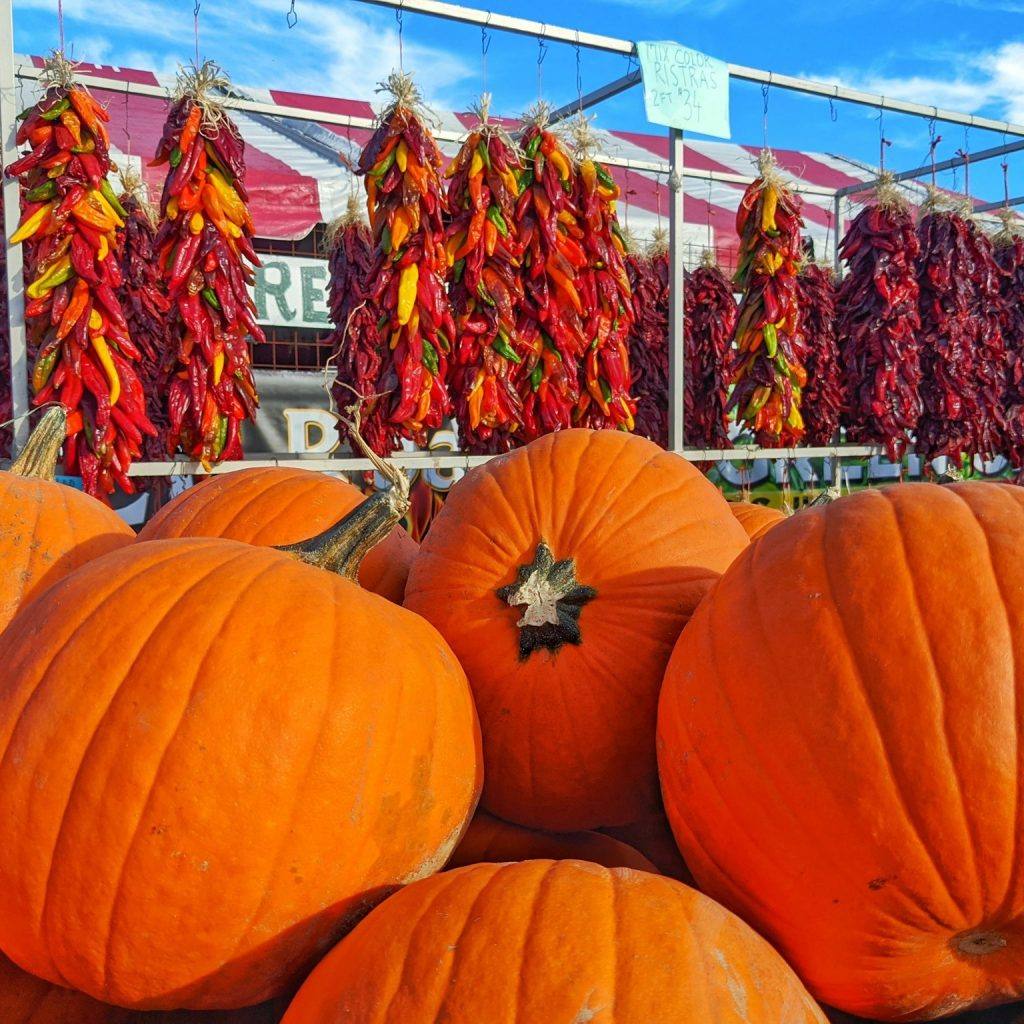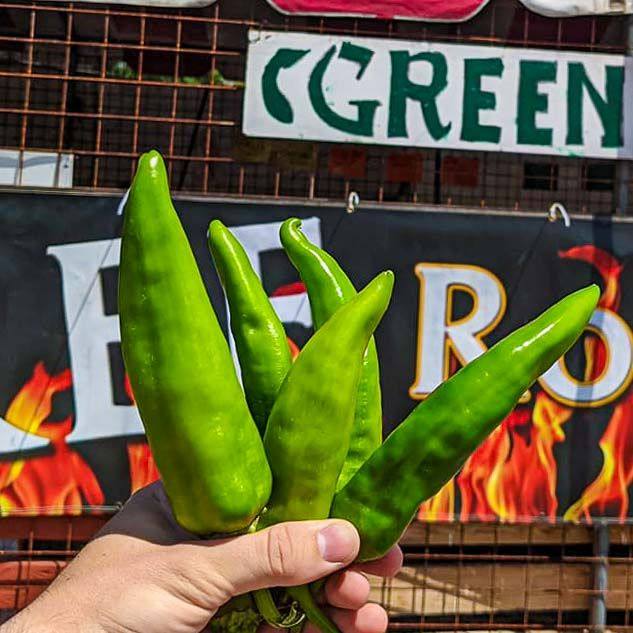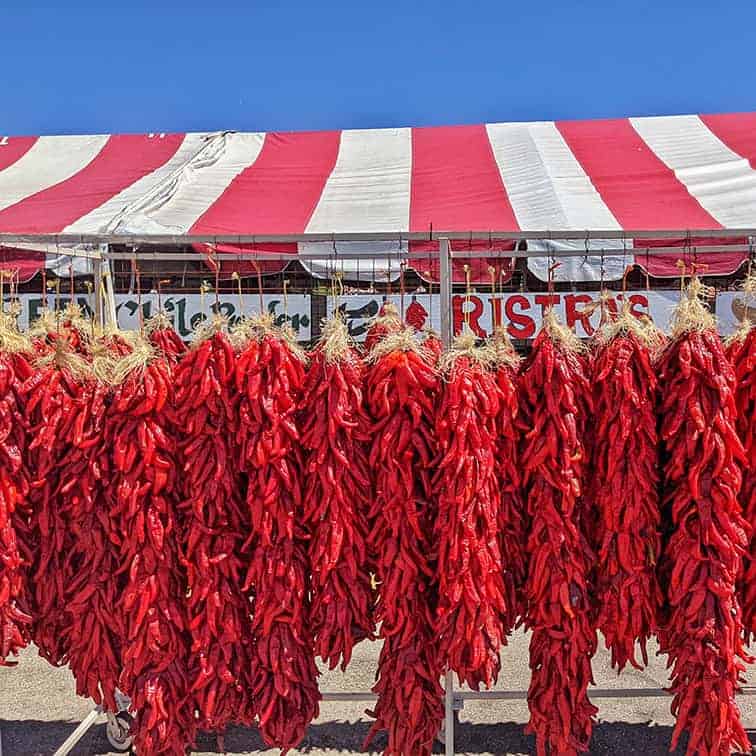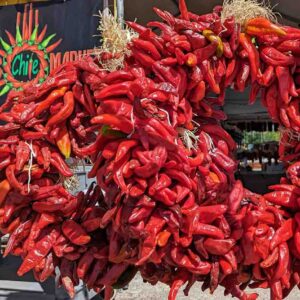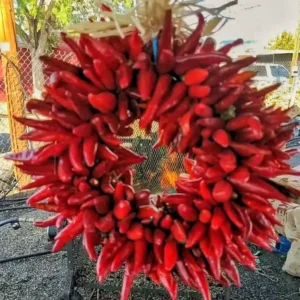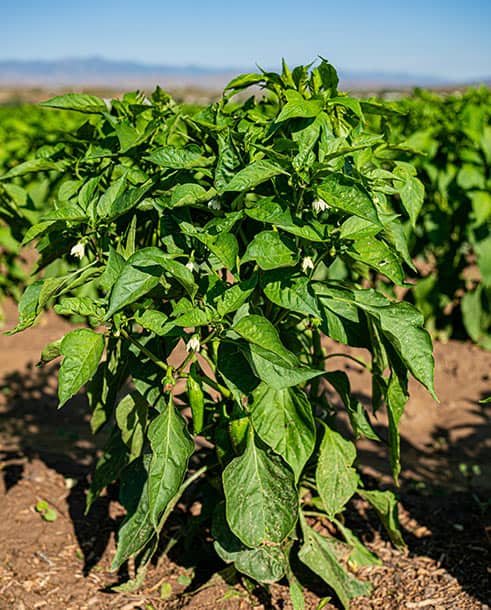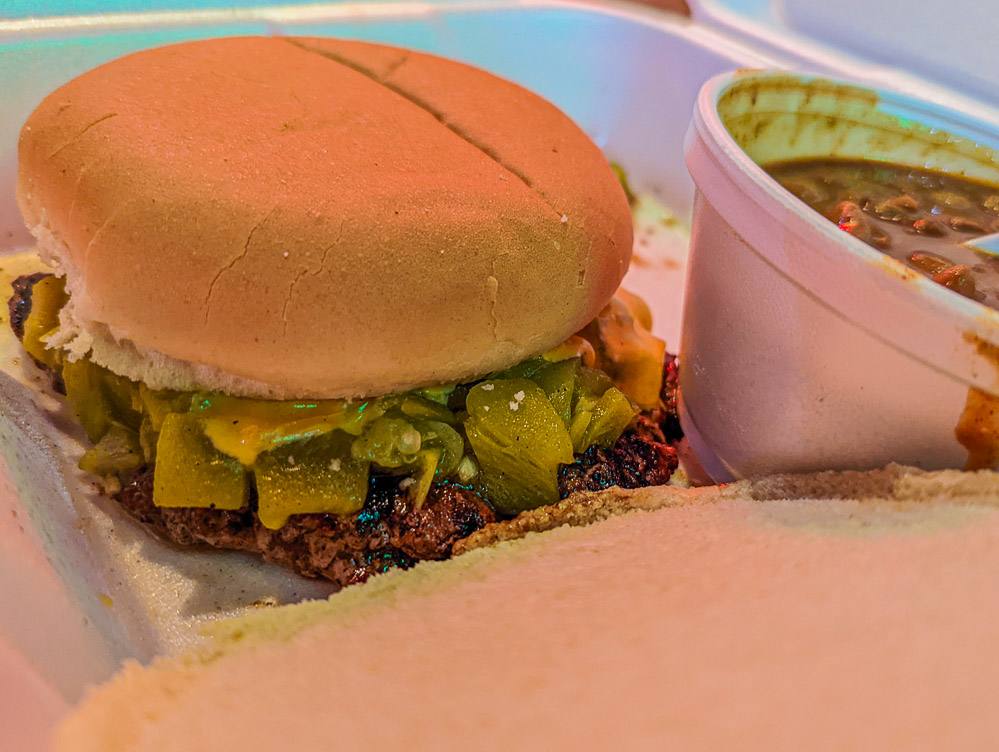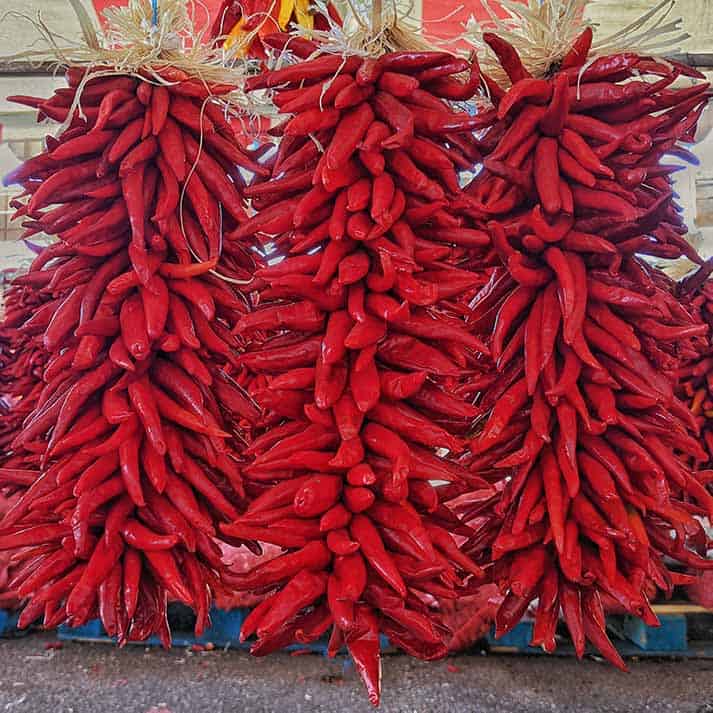Your cart is currently empty!
Category: ristras
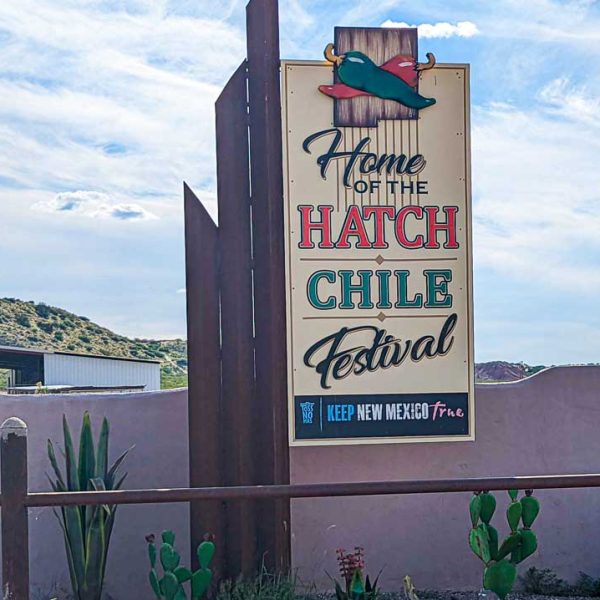
The 2025 Hatch Chile Festival
People around the world love New Mexico chile, because it has a good manageable amount of heat and a lot of meatiness that can be used to pack a lot of chile flavor into any food you can imagine. Of New Mexico chile, Hatch chile is the most famous by far. In fact, Hatch chile is a more popular way of saying New Mexico chile, though the chile varietals are named Numex at NMSU’s chile breeding program. One of the main reasons Hatch is so famous, besides the excellent terroir, is the Hatch Chile Festival. This annual festival takes place on Labor Day weekend every year, and is as big to Hatch as the Balloon Fiesta is for Albuquerque, Zozobra is for Santa Fe, or the Chile Drop for Las Cruces. Visiting a chile roaster is a great travel idea, and Hatch is the epicenter of chile roasting in New Mexico during the chile festival in 2025, and beyond!
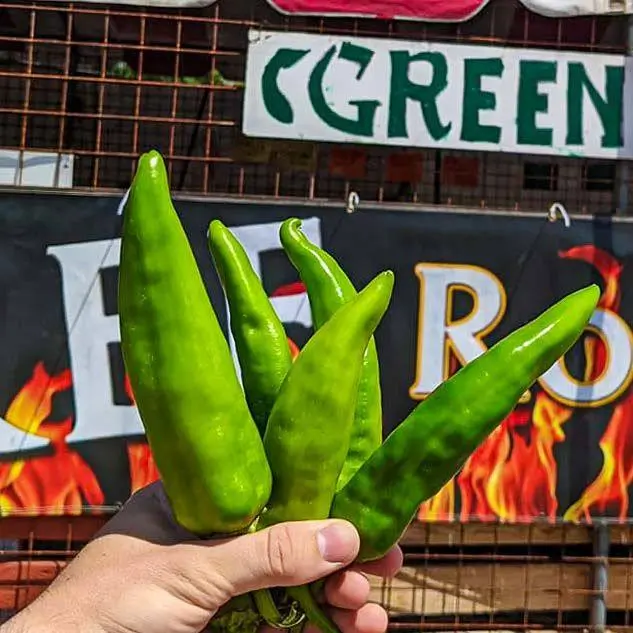
This is what you came for Hatch Chile Festival History
The original Hatch Chile Festival was held in 1971, with just a few local growers. It was a small event for a small town, but but it was special and more and more interest developed over the years. In modern times, the festival has become quite popular, with people traveling from all over to visit. As a year had to be cancelled due to covid, 2025 marks the 53rd Hatch Chile Festival.

Welcome to Hatch! When is the Hatch Chile Festival in 2025?
The Hatch Chile Festival always takes place on Labor Day Weekend, which is August 30th and August 31st this 2025 chile season. As Labor Day is very early this year, I wouldn’t expect a huge amount of chile ristras available unfortunately. There will certainly be some farmers who purposely let their green chile ripen early instead of harvesting in order to sell ristras however, so you will definitely be able to find some nice ristras still.

If you see this water tower, head east to the festival or west to the fields! Layout of the Hatch Chile Festival
The festival has several distinct areas, with the epicenter being around the intersection of Franklin and Hall Streets. The high school pecan orchard is one major area, from there, there is a lot to do going west and south. It is overall fairly walkable, but there is a shuttle bus that you can ride that has a stop in front of the orchard on Franklin Street too. In case you are planning to go to shops on Franklin street north of the Circle K, I recommend going by car, as the shops on the road towards I-25 are more spread out and lack shade.
Where to park for the Hatch Chile Festival?
Most years, the best place to park is at the Hatch Valley High School. If you are coming into Hatch off of I-25, turn left just after the Circle K onto Herrera Rd. The pecan orchard at the high school is used to host some events, like auctions, shows, and competitions. I’ve parked there for free the last few years, but they may charge for parking at some point. From the school, you can proceed southwest to the downtown area on foot.
What to Eat at the Hatch Chile Festival

Sparky’s is located at the biggest intersection in Hatch. It’s packed around lunchtime, so expect to wait Walking southwest from the Pecan Orchard, you can find restaurants like Sparky’s to get a green chile cheeseburger. You might have to wait a while, as the lines run around the block during chile fest weekend. In case you are looking for quicker food that can be consumed on the go, make a quick stop at B & E Burritos. For those of you looking for a place to sit down, Pepper Pot is also a nice option! Valley Cafe is also nearby and has great reviews, but I can’t comment from personal experience. I will try to go this when I visit Hatch! In addition to restaurants, there are also plenty of vendors selling small foods and refrescos! You are never far from a snack or drink during the Hatch Chile Festival!

This is a stacked red chile enchilada plate from Pepper Pot! A Mostly Walkable Festival
Going further west along Hall Street, you will see more restaurants and grocery stores. When you see Village Market, if you go north on School Street, they often have a carnival with various rides and games to play at the lot on the corner of School and Hill Street. In case you are walking, there isn’t too much reason to walk much past Chile Fanatic on Hall Street, as the town gets very spread out around there. In case you want to visit the Grajeda Farms store, it’s better to go by car.
Hatch isn’t a big city, so you can walk from one side of town to the opposite side in about half an hour. As Labor Day weekend is still summertime, be sure to drink plenty of water, and rest in the shade if you need to. Stop in a grocery store or restaurant for air conditioning and refreshments if you feel overheated. The vendors here have the chile roasters blasting all day, so it can be somewhat hard to cool down without making a specific effort to do so.

The gazebo in the park is also a nice spot to sit down out of the sun! What to do at the 2025 Hatch chile Festival
Feel the pulse of New Mexico chile
This is an event that encompasses the entire town. If there is a business in Hatch, you bet it will be open during the event. I don’t really recommend driving around town unless you have somewhere specific to be. It’s way more fun to walk around and see all the sites, different stores, vendors, and artists in the community. Although Hatch is a small town, it is lively during chile season. During this event, it becomes a whole city devoted to chile. Whether you want food, candy, earrings, or fashion related to chile, you can find it. You will even find people dressed as chile, as well as people with hats decorated like ristras, chile roasters, or some other chile related thing.

You can find this sign right in the middle of Hatch! Buy a Ristra
Hatch, New Mexico during the chile festival has more types of ristras than literally anywhere in the world! If you want to take back a chile souvenir, shopping for ristras in Hatch is a great idea. From the normal large straight sandia chile ristras, chile wreaths, chile pequin ristras, these yellow chile guerito ristras, or even garlic and onions, you can find them in Hatch during the festival!

Learn to tie a chile ristra
During the festival, you will be able to see people tying chile ristras in many different places throughout the village. If they aren’t too busy, feel free to ask them to show you how to tie a ristra, and maybe you can even make your own! In case they are too busy to teach you, I have a brief guide on tying a ristra on my page about chile ristras.

You can find ristra tying classes in the Hatch Valley High School Pecan Orchard! Learn How to Roast Chile like a pro
The same thing goes with roasting chile, if the roasters are busy, try not to ask too many questions and just observe. The competition for chile roasting in Hatch is very fierce, which means the roasters need to be on point. In case you come at a very busy time and are unable to ask your questions about roasting, I have a guide to roast on a barrel roaster too! Roasting at scale is very different than roasting on a BBQ grill or an oven broiler. The heat levels need to be much higher to properly blister the chile before evaporation of water lowers the temperature. The guide above goes in depth about roasting both at home and with a giant barrel shaped pepper roaster! It has plenty of ideas for those who are roasting a little, or even those who want to set up their own chile operation!

You will have plenty of chances to see these chile roasters up close! Make a silly Chile hat and dress up!
Part of the fun at the chile fest is to be creative, and do what you can to enjoy all things chile with different people! Every year, there are competitions related to chile related fashion! You can see people dressed up in clothes that make them look like a chile pepper, or even see chile roasters made into hats!

I like his fashion! Check out a Firetruck
As a chile roaster in Albuquerque, we rely on the fire department to keep us safe, as roasting chile is dangerous. We have a first responders discount as one way of showing our appreciation to them. Hatch is no different, and there are many chile roasters who know that the fire department will be there in minutes if there is a roasting mishap. During the festival, they show off their firetrucks, and show kids how they work! My son loves firetrucks, and is always super happy to see all the different technology involved in them. He got a great explanation about it from the Hatch Fire Department!

Be sure to show your kids how cool these firetrucks are! Cool off at Icebox Brewing
Across the street from Sparky’s at the main intersection of Hatch, you can find Icebox Brewing. Next to here is often a stage with live music performances that go until about 10 pm. During the chile fest, you can find many different people enjoying a cold beer here, and there are often specialty beers which are made specifically for the Hatch Chile Festival!

This beer was spiced up by a rim of chile powder! You can find some interesting stuff at the Chile Festival Get a Sack of Roasted Hatch Green Chile
As the festival always happens on Labor Day weekend, it is often a bit early for fresh red chile, especially in 2025. That being said, it is the perfect time to get a full sack of Hatch green chile roasted for you there, or raw to take back home with you! This is what makes the town of Hatch so famous, so it’s a great time to stock up for the year!

You can even take a whole car worth of chile back home with you! A word of caution to the superhot lovers

Don’t come to the Hatch Chile Festival looking for superhots New Mexico chile is a great chile, but it isn’t going to blow you away in terms of heat if you eat ghost peppers like candy. Our chile is a huge part of our culture, but we use it for much more than just the heat. It is the soul food for us in New Mexico. Heat is important, but not the only thing we are looking for. Even our Lumbre Chile, which is arguably the hottest chile, and certainly the most consistently hot chile we grow a lot of in New Mexico only ranges around 10,000 Scoville. When you compare it to Carolina Reapers or Pepper X, it is less than 1% of the heat level. That being said, there are way more ways to cook with our chile than superhots. Additionally, you can always make a chile relleno and put ghost pepper powder in the cheese to kick it up about 10 notches. Good luck making a chile relleno with a 7-Pot. Don’t come to the festival expecting the hottest chili peppers, it isn’t about that.

Roasted green chile is the real magic of the Hatch Chile Festival The Hatch Chile Festival is a celebration of New Mexican culture and cuisine that goes far beyond just spice. If you are looking for the hottest stuff around, there are plenty of other events which may suit you better. If you want to see the celebration of many small local New Mexican businesses and enjoy the warmth of both the food and the people, the Hatch Chile Festival is for you. Welcome to New Mexico, and see you on Labor Day Weekend, 2025!

And these red chile ristras are a welcome bonus too! Hatch Chile Festival FAQ
What is the Hatch Chile Festival?The Hatch Chile Festival is the largest event in Hatch, New Mexico the Chile Capital of the World. It is an event that encompasses the whole town, with carnival rides, shows, competitions, many different vendors, and much more! 2025 is the event’s 53rd iteration!
When in the Hatch Chile FestivalThe Hatch Chile Festival is on Labor Day weekend every year, with the dates in 2025 being Saturday, August 30th and Sunday, August 31st this year. There is also a carnival and music which starts on Friday evening, the day before the main events start.
How much does the Hatch Chile Festival cost?As the festival encompasses the entire town, the base cost is free! Parking has been free in recent years, but is not guaranteed every year. If you plan to go shopping, the roasted chile will likely be about $40 a sack this year, but small amounts are also available for purchase. Additionally, there are many vendors selling different decorations, fashion, jewelry, and much more. This is an event where someone could spend $5 or $1,000 depending on what kind of shopping they do!
Is Hatch, NM worth visiting?In case you like New Mexico chile, it absolutely is worth a visit during the chile season! The Hatch Chile Festival is an especially good time, as it becomes very lively with lots to do and see. Hatch is also a great place to stop in case you are taking an I-25 road trip in New Mexico! Outside of the chile season, it is a small town without too much to do if you aren’t related to the chile business. Many local businesses are closed on Monday, Tuesday, and Wednesday.

small town, big flavor 
Not Just Pretty Peppers: Why Chile Ristras Are the Perfect New Mexico Gift
New Mexico’s vibrant culture, dramatic landscapes, and fiery cuisine all leave a lasting impression on visitors. But when it comes to picking the perfect souvenir, what truly captures the essence of the “Land of Enchantment” and offers year-round enjoyment? Look no further than the humble chile ristra.
A Tradition Steeped in History and Practicality
Ristras are more than just decorative strings of peppers; they’re a time-honored tradition with deep roots in New Mexican history. Originally, they served a practical purpose. Farmers would string chile peppers together after harvest, allowing them to dry naturally in the warm New Mexico sun. This ingenious technique not only preserved the precious crop for winter use but also added a festive touch to adobe homes, symbolizing a successful growing season and the promise of flavorful meals to come. An added benefit is that it protects the chile from birds, who love to eat chile seeds.
A Gift for Every Occasion: From Birthday Cheer to Wedding Wishes
The beauty and versatility of chile ristras make them a fantastic New Mexican gift for any occasion.
Birthdays and Anniversaries:
A vibrantly colored ristra in a festive length adds a unique touch to a gift basket. For a standalone gift, a ristra can symbolize warmth and passion, perfect for celebrating another year with a loved one.
Weddings:
Miniature ristras or artistically crafted chile wreaths make delightful favors for guests, adding a touch of New Mexican flair to the celebration. For the happy couple, a larger ristra hung above the doorway serves as a lucky charm, a fiery symbol of abundance and good fortune in their new life together.
Thinking of You or Get Well Wishes:
A brightly colored ristra with a basket of New Mexican treats is a thoughtful way to send warm wishes to someone far away or recovering from an illness. The vibrant colors and promise of future enjoyment can offer a much-needed pick-me-up.
A simple southwest souvenir:
In case you visit New Mexico, a chile ristra is a great thing to take back with you to remember your visit to the Land of Enchantment. It’s also a great thing to give as a present on your return home. The best part is that chile ristras are edible, and can make an amazing red chile sauce, just take chile off the bottom of the ristra and tuck the string back up to hide it. Be sure to check out our guide to making a red chile sauce for inspiration of how to use your ristra and bring you back to the flavors of New Mexico!
A housewarming present
A chile ristra is a great home decoration, and is a fantastic way to welcome someone into a new home. The ristra can be an exclamation point on the new phase of life someone enters when they move. More than just that, it can add a touch of spice to their cuisine for years to come!
A Gift That Goes Beyond Decoration: The Culinary Connection
Not all ristras are created equal. Look for untreated ristras if the recipient enjoys cooking. These beauties can be rehydrated and used to create everything from fiery salsas to rich stews, bringing the authentic flavors of New Mexico straight to their kitchen. For those who prefer a decorative option, treated ristras maintain their vibrant color for years, adding a touch of the Southwest to any kitchen or living space. At Farmers Chile Market, we are a simple food store, and do not treat ristras. There are many guides online to treat ristras, and it can be done with laquer, shellac, hairspray, clear acrylic spraypaint, or even melted beeswax! Just be sure the ristra is completely dry before treating it, as residual wetness inside of the chile will mold and cause the ristra to decay if it is not fully dry before treatment.
Gifting a Piece of New Mexico: More Than Just Chiles
Whether you choose a decorative or culinary ristra, you’re gifting more than just peppers. You’re giving a piece of New Mexican tradition, a symbol of resilience and resourcefulness that has been passed down through generations. Ristras represent the state’s warm hospitality and vibrant spirit. So next time you’re searching for the perfect gift, consider the humble chile ristra. It’s a gift that’s both beautiful and practical, a taste of New Mexico that will be cherished for years to come.
Beyond the Gift: Exploring the World of Ristras
For the chile aficionado on your list, consider pairing a ristra with additional New Mexican treats. A bag of red or green chile powder allows them to experiment with the state’s signature flavors in their own kitchen. Gourmets will appreciate a jar of local honey infused with the smoky heat of red or green chile. Chile pasado is a great way of taking the flavor of roasted green chile back with you, to share with friends and family. These additional touches elevate a ristra from a simple gift to a curated culinary experience, allowing the recipient to fully immerse themselves in the unique world of New Mexican cuisine.

2022 Hatch chile season
It’s July now, and that means green chile is almost ready! Although some farmers have already started harvesting chile, we believe it isn’t up to our standards yet. We will start roasting on August 4th, 2022 starting with Medium and Hot varieties, and more to come later as more chile matures. In case you are on this page in 2024, we will start roasting on Friday August 2nd 2024!
If you can’t wait and need chile now, here is a guide to make sure you get the best chile possible, wherever you buy!
No matter where you are, the chile season is a great time to get some spicy chile peppers from the chile capital of the world, New Mexico. The season starts with a few varieties of chile which range in a medium to hot heat level. Mild is not grown in large quantities, so it generally will be available later as a result. The hotter the chile is, the more difficult it is to grow to a level where it roasts well, so extra hot and lumbre chile usually arrives two or three weeks after our first shipment. More than just that, green chile is only one side of the flavor experience you can get during the New Mexico chile season. Green chile ripens to red chile as the season progresses, and lets people have access not only to Autumn roast chile, but also fresh red chile.
Red chile
We will start getting fresh red chile in the month of September. We can roast it for those who like the sweet roasted flavor of fresh red chile. It is also great for tying your own chile ristra, and we will be glad to teach you how to do it.
As always, we will have a great variety, including special shape pequin ristras and muti-colored ristras, in addition to the traditional sandia red chile ristras. You can be sure that our prices will be competitive with any seller in Albuquerque and definitely better priced than any other chile stores in the northeast heights.
Our 45th chile roasting season
Although we have been selling Hatch chile since the early 1960s, we started roasting chile in 1977. That means this year marks our 45th year roasting chile in Albuquerque. Thank you for continuing to make Farmers Chile Market your choice for the 2022 New Mexico chile season. Follow us on Facebook if you want more information or up to date information on our chile roasting operation this year.

Albuquerque Chile
If you think about chile in Albuquerque, probably two names come up, Farmers Market and Fruit Basket. A large reason for that is that we both have a lot of history in Albuquerque.
When we first started roasting chile in Albuquerque in 1977, chile was already a large part of the cuisine, but roasting chile was definitely inconvenient. It would take people all day to roast and peel their sack of chile. Once people saw the convenience of our chile roasting, it became hugely popular almost immediately. Even though our Osuna store had a large parking lot, people would still park down the street and walk a long way to get the first fresh roasted green chile in Albuquerque. The first few years we were so busy that it was hard to keep up.
Chile in Albuquerque, then and now
Nowadays, things are a lot different. There are three main ways it differs, besides the obvious 45 year gap. For one, There are a lot more big businesses involved in chile. Competition is a lot more now, with tons of different new faces in the chile business here. The third difference is the varieties of chile. Read on to learn more about how chile has changed in Albuquerque.
Hatch chile = big business?
Green and red chile has become more and more about big business. Many companies sell boxed chile and processed chile products which look nice to grocery conglomerates, but generally aren’t as flavorful. That kind of chile is what happens when you use corporate techniques to apply math to farming. It certainly produces more yield and more profit, but you can’t put a number on flavor. In Albuquerque and all around New Mexico, grocery stores like Walmart and Smiths sell chile incredibly cheaply. If you want the cheapest chile you can find, I recommend you go to a large grocery store. You get what you pay for however, and every year we have hundreds of people come to us after being disappointed by the flavor of cheap chile at big stores.
New chile roasters

A nice Autumn roast When we were the only roasters in town, we had a captive audience. Nowadays, there are a lot of different chile roasters in Albuquerque like Sichler Farms, Chile Addict, and Rosales Produce. This is great for the average person in Albuquerque, because there are a lot of chile roasters in convenient areas. More than that, there are plenty of people that sell chile on the side of the road. With all places, there are pros and cons. I will say that shopping around is a good idea. A lot of places aimed at tourists charge way too much for their chile products. Farmers Market’s slogan has been “Where a fast nickel beats a slow dime” since 1963, and we operate under the same idea. We will always be one of the most affordable chile roasters who sell good chile, because we would much rather make less money and get loyal customers who come back to us every chile season. As a business running for nearly 60 years, we know that keeping customers happy and giving them good value is the key to long term success.
Varieties of chile

Many different varieties of New Mexico chile Finally, chile has a lot more varieties now. New Mexicans love chile, so any chile product you can find in Hatch can probably also be found in Albuquerque. When we started roasting in 1977, Big Jim had only been released for two years. Although Big Jim is now arguably the most famous New Mexico chile, back then no one even knew about it. Nowadays, there are many new varieties like lumbre and miss Junie that come on the market every year. More and more, growers and researchers are able to get more and more heat in bigger and bigger chiles. A pepper the size of Lumbre would never come close to being that spicy in the past. This is done through cross pollination entirely, as chile plants are not possible to genetically modify. More variety of chile means there are a lot more flavors available in Albuquerque’s favorite food.
Chile things to do in Albuquerque
Start by visiting Farmers Chile Market at 2010 Eubank Blvd NE. We are the original chile roaster in Albuquerque, and generally do a very good job with chile, satisfaction guaranteed. After that, drive south on Eubank, past I-40 and turn right on Central to see Route 66. This road will take you through Nob Hill and downtown, two interesting Albuquerque areas with plenty of local art, restaurants, bars, and things to do. Once you are done exploring downtown, Fruit Basket on 4th street is a good place to see. Their philosophy is similar to ours in terms of pricing, so you can be sure to get a good value there along with a good selection of produce. Not far from there is Big Jim Farms, a place where you can pick your own chile. I’ll warn you, picking chile is backbreaking labor, make sure to drink plenty of water.
Other things to do in Albuquerque
Although there are plenty more places to visit for chile in Albuquerque, by now you probably have more than enough chile products. Other interesting things are the zoo and botanic garden and Old Town, which are both in the same area. If you take a walk through old town, you will see lots of local stores selling expensive things to tourists. There is a nice plaza with the church San Felipe de Neri, built in 1793 after the original church’s collapse. In this area, there are tons of nice restaurants, so if you see a place that strikes your fancy, it will probably be very nice. If you are traveling with kids, I highly recommend checking out Explora. In December, the River of Lights is cool, but traffic in the area is abysmal. Finally, if you are visiting in October, the Balloon Fiesta is a must see event.
Other things to do in New Mexico
New Mexico is one of the biggest states in the US. There are a lot of places you can see, but be prepared to drive a while for it.
Things to do in Santa Fe
Only one hour from Albuquerque by way of I-25, Santa Fe is a great place to wander around for the day. If you find parking near the Cathedral of St Francis, just leave your car there and wander around. This area of Santa Fe feels somewhat similar to Albuquerque Old Town, but much larger. Many restaurants here are fantastic also, and I highly recommend eating lightly at a few different places while wandering down to the Santa Fe Railyard. This is one of the best things you can do on a date in New Mexico. If you are into art and audiovisual experiences, MeowWolf is a very interesting spot that is also great for kids. Finally, in September, Zozobra is a very unique event though crowds can be somewhat intense.
Things to do in Hatch
The Hatch Chile Festival is a great event for people who really like New Mexico chile. Sometimes people might be disappointed by the lack of variety in terms of superhots, but superhots are not terribly popular in New Mexico. We love spice, but we eat chile for the flavor and texture, not only the heat. You can’t make a meal out of a carolina reaper, but you sure can with green chile. It takes about 3 hours to drive to Hatch from Albuquerque, so consider booking a hotel in Las Cruces.
Outside of the festival, Hatch is a pretty small town. I recommend driving south from I-25 and stopping at any places that look interesting to you. You will find tons of places selling chile ristras, green and red chile, along with souvenirs for your visit. Check out Sparky’s for a green chile cheeseburger if they are open. Honestly, their prices are not cheap, and you probably will have to wait in line, but the burger is good. From there, go west on Hall street, and you can see a few markets, the Hatch Museum, Chile Fanatic, and Grajeda Farms. After you pass Grajeda farms, there isn’t too much. Hatch is a very small town that gets much bigger during the chile festival.
Things to do in Las Cruces
As we are a chile market in Albuquerque, we might have some sibling rivalry with our little brother, Las Cruces. That being said, the Las Cruces Chile Drop is arguably the most new Mexican way to spend New Years. It is held is the Plaza De Las Cruces, which also tends to have a nice Christmas market. New Mexico State University is the organization responsible for most of our delicious New Mexican chile. Be sure to pay the Chile Pepper Institute a visit to learn about all things chile. They have plenty of information about growing, lots of seeds, and plenty of sauces, books, and miscellaneous souvenirs. Mesilla Plaza is a nice spot, and the restaurant La Posta de Mesilla is a great restaurant which has been in business since 1939.
If you take Picacho Ave west, you will pass by the “World’s Largest Chile Pepper” at the Big Chile Inn. If you keep going, you will arrive at Picacho Peak Brewing, which is a cool hacienda with nice craft beer and a popular brunch.

And I thought Big Jim was a big chile Things to do in other areas

Chile farms are beautiful aren’t they? Alamogordo
If you are passing through Alamogordo, the Museum of Space History is interesting, along with Pistachio Tree Ranch, which is a great spot for snacks and pictures. Nearby there, White Sands is also a really cool spot that makes you feel like you are in a different continent. Alamogordo is about three and a half hours from Albuquerque, but it easy to visit if you are in Hatch or Las Cruces.
Truth or Consequences
Truth or Consequences is an artsy town with hot springs. It is a great spot to go and wander around the downtown area, drink a couple beers at T or C Brewing, then mosey on down for a soak in the hot springs. Nearby there, you can also check out Elephant Butte, the main water recreation area of New Mexico. It isn’t as big as other lakes in the US, but we take what we can get in the desert. Truth or Consequences is about two and a half hours from Albuquerque, and is a great place to stop and take a detour if you are driving from Albuquerque to Hatch or vice versa.
Silver City
Silver City is another town where one should wander around the downtown, and explore a lot. It was a town built by prospectors looking for silver in the 1870s. Due to the large population of Americans who arrived there around then, it has a lot of interesting American architecture from that time, giving it a somewhat unique look compared to most other cities in New Mexico. After all, New Mexico only became a state in 1912. Most of our old buildings were built by the Spanish, not the US. Tranquilbuzz Coffee is a great spot to get a cup of liquid energy, and Little Toad Creek Brewery serves up delicious beers and is a great spot for dinner too. Silver city is about four and a half hours from Albuquerque, but it is much easier to get to from Truth or Consequences or Hatch.
In all of these places, you can be sure to find plenty of green and red chile. Some areas, such as Chimayo have their own specialty chile as well.
Explore New Mexico
There are many many other great places to go in New Mexico. In fact, it is somewhat daunting to think about. I started writing expecting to write mainly about Albuquerque, but there are too many good places to visit here. Check out our travel section for more ideas. If you come, make sure to spend some time here, or you will miss a lot of great stuff.

Where to hang a Chile Ristra
It seems like you or someone who cares about you took a trip to New Mexico and you ended up with a Hatch red chile ristra. Congratulations, you have acquired the most delicious decoration in the world. Now, where would you like to hang it?
Getting your chile ristra home
First things first, you need to get your ristra to the place you want to hang it. Regardless of if you want it at your house, your business, or somewhere else, do not bend your chile ristra when taking it there. Some ristras are quite long, and might need to be curved slightly. As long as you do it gently, it should be ok to not be 100% straight. That being said, do not try to fold them or bend them more than about 20 degrees. This will weaken the chile’s connection with the ristra, and lead to increased breakage in the short and long term. No one likes broken chile on a ristra, even though it does give you an excuse to make some delicious red chile huevos rancheros.
Keep it hanging
If you are able to hang it up safely in your car, that is ideal. If you don’t trust the hooks, it is also ok to lay the ristra down for a short amount of time. If you are on a road trip and must lay your ristra down for a few days, make sure to gently turn then ristra several times every day. If you don’t turn it, the ristra may develop an unbalanced shape.

Ristras are the traditional way to dry chile in New Mexico How to display a New Mexico Chile ristra
There are several fields of thought in this regard. Some people prefer displaying their ristra in a very prominent location, such as the front porch, the side of the garage, or a second story balcony. All of these are great options, but need to be evaluated on three main points, which are wind, sun, and rain.
Wind
Wind is the most obviously destructive thing for a chile ristra. Wind causes ristras to crash against hard surfaces, which breaks chiles quickly. Because of that, it is quite easy to see the damage which is caused by wind. Keeping a ristra away from strong wind, and away from surfaces that wind may smash it against is the best thing you can do to keep your ristra looking good.
Rain
In most of New Mexico, we rarely have this problem outside of mountain towns, but if your ristra gets wet and doesn’t dry, it will get moldy. Mold can cause the ristra to look dusty, and also is probably not something you want to eat. Some molds can be good, like mushrooms and penicillin, but unless you have a very good microscope and a lot of knowledge, it is not something you want to risk eating. If a ristra gets moldy, you shouldn’t eat it, which takes away my favorite aspect of chile ristras. They are delicious.
Sun
The sun is something that affects ristras a lot slower than wind and rain. If your ristras stay dry and don’t get beaten up by the wind, a ristra should still look good after a year. It might look dry and older, but isn’t that the point? They are hung like that in order to dry and age gracefully. That being said, if you want a ristra to look good for more than a year, keep it out of the sun.

So, where should I hang the ristra?
This is a personal question that you should ask yourself armed with the knowledge you have gained from reading the above. If you want it to be quite visible, hang it outside for the world to see, just keep it out of the wind and rain. If you want a ristra that will last a long time, keep it in your kitchen, where it won’t get bumped into. A ristra kept in ideal circumstances will probably still look pretty good in 2 years. A ristra in a bad environment might look bad in 6 months. If you want, you can spray acrylic or some other sealant on a ristra to keep it looking good. This will preserve them for longer, but also makes them inedible.
At Farmers Chile Market, we do not spray anything on our chile ristras, because we sell food that doubles as a decoration, not decorations that double as food. In New Mexico, this distinction is quite important. If a place sells treated ristras, they probably don’t think about the flavor of the chile as much. In my experience, the only places who do that are souvenir stores targeting tourists. Chile ristras are food. We don’t sell trinkets, we sell good food at a good price, and it has been that way since 1962.

October is a beautiful time here Check out our chile ristra FAQ for more information about New Mexico’s favorite decoration.

How to choose good New Mexico chile
It’s June now, which means that chile has already been in the ground for over a month in all the major farming regions of New Mexico. We are around 2 months away from the 2024 chile season, and the time is right for a guide to how to pick out good chile.
First things first is to evaluate the retailer you are buying from. If they are a typical grocery store and their chile is cheap, it is probably a chile variety with less flavor than many varieties we and other local New Mexican chile roasters sell. Second, make sure they let you at least try the raw chile to know the flavor. Don’t expect to try Hatch chile already roasted, as it leads to food safety concerns. Spice and other flavors associated with different varieties is impossible to explain. In order to get the right product, you should be allowed to sample the product. If they don’t let you, consider a different place. At Farmers Chile Market, we always let customers try raw chile to get an idea of what the flavor of each chile variety we sell.
How to try raw chile
Tasting chile is very important if you want to get the ideal match of heat and flavor. As chile is a seasonal product, it means every season has different characteristics. Just like wine, tea, coffee and other agricultural products, chile’s flavor also varies based on the weather and other factors. More than just that, there are many different chile varieties to choose from.
Break the chile away from you or anyone else so the juices don’t fly in anyone’s face. No one wants a face full of extra hot chile juice! Try to break it around the middle, as this is where the heat from the chile is most indicative of the spice level of the chile. Raw chile has the majority of its spice centralized in the membranes near the seeds. This means the tip often has very little heat, while near the stem might be like fire. During roasting, the membranes break open, and the juices flow all around during the steaming process, which makes the spice level more uniform throughout the chile. Bite one side, and share the other side with a friend, or throw it in the roaster with your sack of chile if you like it. At Farmers Chile Market, we will gladly explain the differences in flavor and let you try whatever flavor you want. We even have free water, in case you try something a little too spicy. This is one of many little things we do to try to be the best place to get chile roasting in 2024!

Super spicy New Mexican Lumbre chiles. Be especially careful breaking these! How to see if fresh green chile is good
The easiest things to notice are wrinkling and decay. If a lot of the chile looks decayed, go to a different store, as wherever you are obviously doesn’t care enough to remove bad product. We put fresh chile out multiple times a day and always remove decay when we see it, as it can ruin nearby chile as well. Another thing to look for is wrinkling. While a little wrinkling is not too bad, excessive wrinkling can make a chile incredibly hard to roast and peel. In our raw chile section, we rotate out the chile several times, and roast it before it wrinkles too much. Not only that, but we get shipments 3 times a week, so our chile we sell is at most only 3-4 days since harvest. Good chile roasters pay very close attention to these details, and you can be assured to get a quality product. To summarize, a little wrinkling is ok, but don’t trust a place that puts out a lot of decayed chile. Ideal chile is plump and firm, with a flavor that suits you and the people you eat with. Don’t be afraid to try, as you know and understand what flavor is best for you much more than just trusting a sign that says mild, medium, hot, or extra hot.
What to do after buying Green Chile

Many different varieties of fresh New Mexico chile. Notice that there aren’t many wrinkles. Your chile needs to be roasted of course! If the place you buy from has a roaster, ask them to roast it for you. It will save a lot of time! That being said, many bigger grocery stores don’t do a great job at training their chile roasters. I have a guide to roasting chile written for both roasting as a profession chile roaster, and also for roasting at home. If the roasting area doesn’t look professional, odds are it isn’t. I hear complaints regularly from people who go to less professional chile roasting operations every year and are dissatisfied. It is sometimes better to just roast chile at home than get an inexperienced person to roast it for you.

Roasted chile should look like this when finished. Most of the peel is already gone, but it isn’t charred How to choose a good Hatch red chile ristra
To start things off, I should say that decorative things are very subjective, as everyone has different artistic tastes. That being said, there are some things I will recommend looking out for. First, make sure that the ristra is straight. If you see any obvious bends, it probably means the ristra was not properly stored, and will have a weak point, from which chile will easily break off. Second, look at how plump it is. Some ristra makers skimp out on chile, and while the length is correct, it shrinks down a lot once it is dried. A ristra should be quite full, with around 3 chiles per layer. Some ristras have a shape that curves outward a lot, and some have shapes that curl inward. What specific look you like is really up to you. As they say, “beauty is in the eyes of the beholder.” Look for breakage of chile if the ristra is not fresh. Generally you don’t see much decay on ristras. As they age, some ristras will have brown patches on some chile, this is just the color that green chile turns to when it dries. It just means that the chile originally was not completely red when it was tied to the ristra. It will still taste good, even if it isn’t the most pretty chile.
If you have more questions about ristras, our Ristra FAQ has plenty of answers for you.

October is a beautiful time here The New Mexican Chile Experience
If you are from New Mexico, you understand about what it is like to get chile roasted here. For people who are outside of New Mexico and have to rely on grocers in your area, I highly recommend making the chile season part of your reason to visit New Mexico. In October, we have the Balloon Fiesta, the worlds largest hot air balloon festival. It always occurs toward the end of chile season, but we will almost always still be roasting when it occurs, barring freak cold snaps, which do occasionally end the chile season early. One of the coolest things to do in New Mexico is visiting a chile roaster, as you can see the lifeblood of New Mexican food up close. If you come to our chile stand at 2010 Eubank Blvd NE in the northeast heights in Albuquerque, we will do our best to show you a delicious side of New Mexican culture. In case you are planning a trip to New Mexico specifically for chile, I highly recommend checking out the Hatch Chile Festival too!

Chile Ristras are food
Upon traveling to New Mexico, one of the first things someone will notice is chile ristras. The eye catching strings of dried or drying red chile are quite appealing to anyone who likes the southwestern aesthetic. Throughout New Mexico, the red of chile ristras, and the green from green chile are everywhere, even more than the color turquoise in Santa Fe.
Something unfortunate in my opinion, is that for many, chile ristras are seen as only a decoration. Yes, they are beautiful, but they are also wonderful for cooking with, and keep a great flavor for up to 3 years. Typical red chile ristras are made with sandia chile, which is hot, but not too hot. It is a variety which is spicy enough for someone who likes heat, but won’t cause undue pain on a spice novice. Additionally, the natural drying process that the chile goes through gives it a deep somewhat savory flavor due to the fermentation which takes place during drying.
More than just flavor, red chile sauces are incredibly easy to make. All one needs to do is take out the stem and seeds from chile on the ristra, blend it up for about 10 minutes with some garlic powder and onion powder, then boil it with a chicken or vegetable stock. Altogether, the whole process takes less than an hour, and you can make a red chile sauce which will last a year or more in the freezer. For more ideas about what to cook with your chile, check out our recipes section!
The best part about all of this, is that it is quite easy to harvest chile from the bottom of your ristra, then push the string up into the remaining chile to hide it. The ristra gets shorter as you use it, but it still stays quite beautiful. This kind of two way decoration is very good for sustainability as well as being beautiful and delicious. Ristras are a great blessing, and we are very proud to sell 100% edible ristras in Albuquerque at 2010 Eubank. As always, we aim to be the best place for roasted chile in Albuquerque!
If you are curious about ristras, you can learn more in our FAQ

New Mexico Chile Ristra FAQ
All about chile ristras
I get asked a lot of questions about chile ristras, ranging from “How long do ristras last?’ to “How to take care of a Hatch chile ristra?” This made me think that many people will probably be wondering about it online too. Because of that, I decided to make a quick FAQ with my answers and recommendations on it. If you have questions about the beautiful strings of dried New Mexico chile known as chile ristras, read on adventurer. In case you want to see a list of ristras we have for sale, click this link to jump down!
What is a ristra?In Spanish, ristra means string, but is also used to describe a string of chile peppers.
In English, pretty much the only way people use the term ristra is to talk about chile ristras, with a very small minority also using the term to talk about garlic bulb ristras!Why are ristras made?Originally, chile ristras were made only as a way to preserve chile, and keep it available as a food source in the cold winter. In modern times, food is less scarce, and most people make them as a decoration primarily. They still are a great source of food however, and we highly recommend cooking with chile from an older ristra when you get a new one!
How long do ristras last?The answer depends on many factors. An untreated ristra kept in good conditions will still look good after two years. A treated one might last 5 years or more. If it is kept in unfavorable conditions, it will break down sooner. One bad storm can destroy a ristra.
What is the best way to store a ristra?A ristra should be kept hanging, away from wind that will cause it to hit hard surfaces. The sun won’t damage sandia chiles as much as pequin, but will cause fading over time as well. If you want a ristra to last as long as possible, keep it in a cool, dry, and dark place without wind. If you want to display it outside, keep it in a partial sunlight area that is not windy.
Can chile ristras get wet?Although a small amount of water getting on a ristra probably won’t be a problem in a dry state like New Mexico, it should be avoided. Ristras which get wet can become a breeding ground for mold, which will eat the ristra from the inside out!
How spicy are ristras?The traditional New Mexican ristras are made with sandia chile, which is typically considered a “hot” chile. Pequin ristras however are much more spicy. If you want to cook with them, be very careful with the amount you use.
Are ristras edible?Every ristra that we sell at Farmers Chile Market is untreated, and therefore edible. Even if you have the chile after 2 or 3 years, it will still be delicious.
How to cook with ristras?Red chile sauces are incredibly easy to make. All one needs to do is take out the stem and seeds from chile on the ristra, blend it up for about 10 minutes with some garlic powder and onion powder, then boil it with a chicken or vegetable stock. Altogether, the whole process takes less than an hour, and you can make a red chile sauce which will last a year or more in the freezer.
How to use chile on ristra?Take the chile from the bottom of the ristra, then tuck the string up into the remaining chile. This lets you keep the ristra beautiful while also able to eat the delicious red chile from your ristra.
How to make chile ristras?It is a process of tying chile stems together with twine. Check our chile ristras page for a more detailed guide on making a ristra!
What chile are ristras made with?Most ristras in New Mexico are made with sandia chile, though many special shaped ristras are made with chile pequin, also known as chile de arbol as well.
How many Scovilles is a ristra pepper?In case the ristra is using a large Sandia chile pepper, it will be around 6,000. Hot, but not super hot. If it is using small chile pequin, then it will be around 30,000, which is very hot, and will be too spicy for most people, even in New Mexico!
How can I travel with a ristra?If you want to travel with a ristra, it is best to get one that is not totally fresh, but also not completely dry. This is because fresh ristras might rot, and dry ristras are more prone to breakage. Second, it is best not to lay it down for too long, as the ristra may become deformed. If you can rotate it, this problem will be less serious. If you are taking it on an airplane, I recommend wrapping it in something breathable and soft, so it can’t be jostled around too easily, and still has some ability for airflow. When driving, I recommend hanging it on a hook, provided it does not bang against the windows. If you don’t have hooks, I recommend just laying it flat as straight as possible, and gently turn it daily to prevent it becoming deformed.
Where are your ristras from?All our ristras come from the sunny Hatch Valley, in southern New Mexico.
Where is the best place to get chile ristras in Albuquerque?Farmers Chile Market at 2010 Eubank Blvd NE 87112. We get fresh chile ristras in around the start of September every year, and continue selling ristras until Christmas every year.
Why don’t ristras use green chile?Most green chile varieties turn to a yellowish brown color when they dry. In some multicolored ristras, this is not bad, as it provides more color variety. That being said, it looks unappealing compared to red chile ristras.
When are ristras available?Generally ristras are available once Hatch chile has had a time to mature and turn red. This typically happens about a month after chile season begins. New Mexico becomes usually awash in fresh ristras around the start of September.
Are ristras seasonal?Fresh ristras are a seasonal item in New Mexico, with the majority being tied in the months of September and October. Because they are sun dried, they are shelf stable at room temperature, and can be obtained at any time, but they won’t be bright and fresh like the ones you can get during the chile season.
Where do you hang ristras?Hang them in a place which isn’t too windy, so the chile doesn’t get damaged. Partial sunlight is best to avoid fading, but red chile ristras kept in the sun will still continue looking good for a long time. We also have a more detailed answer in our post Where to hang a chile ristra?
Can you eat chile ristras?You can eat Farmers Chile Market ristras once they are dry. Some sellers will treat the ristras with inedible materials to make them look fresh for longer.
What kind of chile is in ristras?Typically ristras are made with large sandia chile pods, a hot New Mexico chile which dries very well. If the chile is small, it is likely chile pequin, also known as chile de arbol in old Mexico.
How long do red chile pods last?If they are stored well, with cool temperatures and low humidity, chile pods keep a good flavor for a few years.
Do you ship chile ristras?We will begin shipping chile ristras in mid-September this 2024 chile season. We have a list of different options for chile ristras on the bottom of our Chile Ristras page.
When are fresh red chile ristras ready?Once the chile has had enough time to ripen to red, chile ristras will arrive within days. When fresh chile ristras come in depends a lot on the chile season, as some years chie matures faster than others. That being said, they are typically ready by early September.
What is chile de ristra flavor?Chile de ristra flavor depends on what kind of chile the ristra is made of. A typical large pepper Hatch chile ristra is made with Sandia chile, which is a hot variety. The types of ristras using smaller chile are typically made with chile de arbol, also commonly called chile pequin in New Mexico. This chile is much hotter, and should be used with caution, as the spice can easily overwhelm most people.
What types of ristras do you sell?We have a really wide variety of ristras, ranging from a few inches to 5 feet long. We also sell different shapes, colors, and chile varieties too! Check out our list of ristras below for more information!
Ristras for Sale
-
Product on sale
 Hatch Red Chile WreathOriginal price was: $89.97.$74.99Current price is: $74.99.
Hatch Red Chile WreathOriginal price was: $89.97.$74.99Current price is: $74.99. -
Product on sale
 Pequin Chile WreathOriginal price was: $49.95.$43.34Current price is: $43.34.
Pequin Chile WreathOriginal price was: $49.95.$43.34Current price is: $43.34.

-

Why is Hatch Chile so Famous?
In New Mexico, chile is a big deal to say the least. We schedule our year around picking up enough fresh roasted chile during the season. If we are running low in October, you better believe we will make a mad dash to the closest chile roaster to stock up ASAP. One place in New Mexico has a lot more fame than other areas, the village of Hatch.
About Hatch, New Mexico
The Village of Hatch is a small town with a population of just 1,648 according to the village website. Even with such a small population, it has managed to generate enough renown to call itself the “Chile Capital of the World.” Part of this is due to the farmland there and in surrounding areas producing so much delicious New Mexican chile. The long Hatch valley running along the Rio Grande provides a great terroir to grow some delicious chile.
The Hatch Chile Festival has been held since the 1970s, and will celebrate its 50th anniversary this year, in 2022. Although plenty of other great growing regions exist in New Mexico, this event causes the population of Hatch to temporarily grow about 20 times larger. Spice lovers from all over the world come together to celebrate the love of spice. Plenty of different competitions related to best salsa, spice tolerance, food, and much more is available to do.
Additionally, if you drive through the town during the season, you will see chile being roasted on literally every street corner, and ristras being used to decorate every shop, restaurant, and house. You can even find plenty of places who can teach you how to tie your own ristra. Additionally, there is a lot of decorative stuff for sale as well, tourists often buy those kinds of things, and Hatch is definitely focused on selling to tourists. We have plenty of chile ristras in Albuquerque also.
Even in the off season, you can find a lot of stores still open, but they won’t be selling fresh chile anymore, instead selling frozen and dried chile.
Great Burgers at Sparky’s

Sparky’s has a great burger worth trying If, like many other people traveling to Hatch, you are looking for a great green chile cheeseburger, Sparky’s is arguably the most famous place in New Mexico. They certainly have a delicious burger, with a decent heat level. It isn’t really cheap, but burgers worth traveling for rarely are. There is a ton of classic Americana decorating this place, so there is a lot of cool stuff to look at and take pictures of while you are waiting for food here.
Hatch chile and New Mexico chile
Hatch chile is great, but New Mexican chile culture is also a force of nature. The Rio Grande river valley goes right through the middle of New Mexico. Lots of farms grow in a very similar terroir to Hatch all throughout New Mexico. The elevation of Hatch is about 4,000 feet, where the elevation of Socorro is about 4,600. That region is also quite well known among New Mexicans, but not nearly as famous worldwide as Hatch.
Even the words “Hatch Chile” is much more popular than “New Mexico Chile,” even though chile produced at the Chile Pepper Institute of NMSU bears the title NuMex. Whether people say Hatch chile, New Mexico chile, Socorro, or Lemitar, we know that it is probably good stuff if grown in New Mexico. At our store, we sell chile from various parts of the state. We will always let you know where it is from and invite you to sample it before you buy. We pride ourselves on being the best place to get roasted chile in Albuquerque.
So, what makes Hatch famous? Personally I believe it is a combination of many things, including the overall chile tradition that they have. There are many growers, a supportive government, location close to NMSU, and great restaurants which spread the message as well. Even though it is a small town, when people come together and know what they stand for, great things happen.

The Many Varieties of Chile
Many types of New Mexico chile
Although we sell green chile by temperature, Mild, Medium, Hot, Extra Hot, XXX-hot, etc, the differences between New Mexico chile varieties run deeper than that.
Chile has been a big thing in New Mexico for a long time, and as a result, many different varieties exist. Many are bred for their size and meatiness, such as Big Jim. Some are bred to bring the heat, like Lumbre. Some chile is bred to mass produce, like Arizona 88. We don’t sell that one, as it is an inferior product, but most giant grocery stores do. Everyone has something different they look for in New Mexico chile, and that is why we let people see and try the chile before they buy. It is important for us to make sure you have the best possible chile experience.
The purpose of Different chile
Every chile serves a purpose, which includes much more than simply heat level. For our hot green chile, we generally get Miss Junie. Our ristras are made with Sandia, a chile variety developed by Roy Harper in 1956. Both are a solid “hot” temperature, but the Miss Junie a is slightly spicier, more meaty variety, which means it will roast better. Sandia is less so, which leads to better drying.
There are many different things that consumers look for in chile. Sometimes they need chile that is long and straight, so they can make chile rellenos. Big Jim, a cultivar developed by Roy Nakayama in the 1970s is typically the best for this. The mild 1904 and 6-4 varieties also work, as well as the hot Miss Junie.
Sometimes, people want as hot as possible. Traditionally, Barker was the choice for spice-lords, but Lumbre has overtaken its throne in recent years. Barker remains as the primary extra hot variety at Farmers Chile Market and most other chile stores. Lumbre is our XXX-hot variety.
The original New Mexico chile pepper was Numex No. 9, developed and released by Fabian Garcia a little over 100 years ago. Although it is not as common as other famous varieties of New Mexico chile in modern times, its purpose as the forefather of Hatch chile will always be significant.
Differences in the same varieties
Red or Green?
Red chile and green chile is another factor which is important. Green chiles have many differences with red. Red fruits are more mature, with a lot more sugar. They take longer to roast, and the peel is more resilient. They also dry much better, and hold their shape well, where green typically shrivels and doesn’t look great.
Red Chile
New Mexico chile typically ripens up to become red chile. Fresh red chile is quite sweet, but most people don’t eat it when it is fresh. Instead, most red chile is sun dried. These sun dried red chile pods are then ground into red chile powder by processors in Hatch New Mexico, or sold to consumers as whole chile pods. These pods are the base of New Mexico’s mother sauce, the red chile sauce. The arrival of fresh red chile is also a big milestone in the chile season, as it means that chile ristras are available. Although ristras are often used as just a decoration, they are also edible if they are untreated, and many fantastic chile sauces are made with chile ristras!
Green Chile
The arrival of green chile marks the beginning of what people refer to as the chile season, which typically goes from the start of August to nearly the end of October. Green chile is almost exclusively roasted and peeled before eating, but green chile powder has also become more and more popular in recent years. After roasting, it is typically bagged up in freezer bags and frozen for consumption at a later date. Chile Pasado is another way to preserve roasted green chile by drying it. Green chile is much less sweet than red chile, and I would argue that its flavor is somewhat more grassy and herbal than red. Due to it needing to be roasted to peel it off, I recommend finding a good chile roaster, or reading our guide to roasting green chile!
Common New Mexico Chile Varieties
Mild Chile Types
There are many chile varieties such as R Naky which are primarily grown as paprika type chile, and not meant to be roasted. As we are a chile roaster, we will primarily focus on chile commonly used in roasting or making New Mexican food.
New Mexico 6-4
This variety was developed as a team effort at NMSU based on Numex No 6, which was released by Dr. Roy Harper back in the 1940s. In Modern times, the NuMex Heritage 6-4 variety has become more common. It’s heat level is typically around 1,500 Scoville Heat Units, SHU or less.
NuMex Joe E. Parker
Another mild variety which was released in 1990, this chile is typically around 1,000 SHU.
Medium Chile Types
Big Jim Chile
The Big Jim chile variety was developed by Dr Roy Nakayama in the 1970s at NMSU in collaboration with famed chile farmer “Big Jim Lytle”. This chile went on to be labelled by Guinness as the world’s largest chile pepper. Possessing a medium heat, this is by far the best chile variety to be used for chile rellenos! In modern times, NuMex Heritage Big Jim has become more common. Big Jim is somewhat notorious for being a bit inconsistent in heat level, with some peppers being rather mild, while others are up to 9,000 SHU. Along with something I like to call “spiceflation,” or the perceived heat level going down as people desensitize themselves with hotter and hotter chile, more and more people are regarding Big Jim as Mild. We still classify it as medium, because it has been for the past 50 years. Maybe we will change this at some point, but we also have a long history and want to respect our New Mexico traditions!
Hot Chile Types
Sandia Chile
This is the traditional “hot” New Mexico chile, and has been since it was release in the 1956 by Dr. Roy Harper. Sandia is the primary chile used to make red chile ristras in New Mexico. A more modern version of Sandia, known as Sandia Select is also a great chile for roasting, as it is bigger and thicker.
Ms Junie
This relatively new chile variety was developed by Solar Dry Chile in Hatch. Named after the late, June Louise Franzoy Lytle Rutherford, this chile is somewhere between Big Jim and Sandia in size, while also being hotter than Sandia too! Although some chile vendors will mark this as an extra hot chile, it still is lighter in heat level than a Barker variety. Miss Junie is an amazing chile for roasting as it is big, thick, and juicy! It even works great in chile rellenos too. One major downside to it, is that because it is so juicy, it doesn’t dry as well in the sun. This is why ristras are usually made with Sandia chile over Ms Junie still.
Extra Hot Chile Types
Barker Chile
Barker chile has been the typical extra hot variety in New Mexico for as long as I can remember. It is quite a bit smaller than either Sandia or Miss Junie, but is almost always a decent amount spicier than either. Barker is more difficult to roast than other varieties of chile, as it is more prone to burning. It is not as juicy as many types of chile, so a roaster needs to pay attention when roasting this variety.
Hotter than Extra-Hot Types
Lumbre Chile
As of now, the most consistently hot New Mexico chile variety I know of is the Lumbre chile. It was developed in recent years by Jimmy Lyttle, son of “Big Jim” Lyttle. This veins of this chile are yellow, orange, and red, which should frighten you if you are afraid of spice. When we roast this chile, even the air around the roaster becomes spicy. We call this chile XXX-hot, because it is dangerous how spicy it is. Although it won’t be too hot for someone who eats ghost peppers like candy, when you eat a dish with a green chile sauce made of lumbre chile, you will feel the heat! We also try to carry this in dried red chile pods, but it often sells out within a day or two. If you see lumbre red chile pods, buy them right away!

Super spicy New Mexican Lumbre chiles Other types of chili Peppers
Superhot Chili Peppers
Superhot chilies are a new trend in chili pepper cultivation. twenty five years ago, the hottest peppers you might find would be things like habanero and scotch bonnets. Although the red savina pepper was the hottest in the world, few people really knew much about it at the time. The first superhot pepper to really kick off the modern spice craze was the bhut jolokia, or ghost pepper as it is most commonly known. Dr Paul Bosland of NMSU’s Chile Pepper Institute said this pepper “kind of opened the floodgates.”
Since then, other peppers emerged, with a new one taking the crown every year or two. Trinidad moruga scorpions were the top dog until they got overturned by the Carolina Reaper, which as just recently been overtaken by Pepper X. The amount of superhot chile varieties available now is immense, with tons of growers and researchers trying to make their own mark. One popular chile variety is the 7 pot, which has many different strains. You might have heard about a California reaper, which is a yellow version of the red Carolina reaper.

New hottest peppers
Although unconfirmed by Guinness, there are some new peppers that are rumored to be even spicier than the Carolina Reaper. If you ever hear of Dragons Breath or Pepper X, be prepared, as they are supposedly much hotter than even the Carolina Reaper. These new chile peppers are pure fire.
Sweet peppers
Along with a boom in superhots came a boom in the sweet pepper department as well. For decades, you could find a few colors of bell peppers at any old grocery store. These mild peppers give a good flavor and juiciness to any dish they are in, along with tons of health benefits. There are a lot of different sweet peppers available, such as the Corno di Toro. The Hamik pepper is one of the sweetest peppers you can find, with sweetness that makes it comparable to many fruits.
Famous peppers around the world
Many countries have their own chile traditions and cultures, just like us in New Mexico. In Japan, their most famous chile is the shishito pepper, which goes really great flame roasted and paired with beer. It is a very common bar food in Japan. In southeast Asia, the Thai or birds eye pepper reigns supreme, but stroll down any market, and you will see tons of different types of chile that you can never find in the US. If you get pho in the US, it typically has jalapenos, but in Vietnam, it typically comes with a local green chili and lime wedges. Mexico, has some of the most famous chile varieties in the US, so we have an entire post about different types of Mexican chile peppers!
India and Sri Lanka are famous for spicy food, which explains why the ghost pepper and naga chile varieties came from there. Trinidad is also quite famous for both the Trinidad Scorpion and the 7 pot varieties of chile. Cayenne pepper is another super famous pepper, and arguably the most used for spice powder which adds heat. Paprika is of course more common, but mild.
The world is a big place, and although I do consider myself a chile expert, my field is primarily related to chile in New Mexico. Because of that, I can’t list off every single pepper, but I can say that the amount of different pepper cultivars is simply astonishing. You will find different chile everywhere you go, as long as the cuisine is one that appreciates spice.
New Mexican Spice
Although there are many different types of chile peppers in the world, New Mexico is unique in a major way. We eat chile with literally everything. In a day, you might have three different meals and a snack, all containing chile. Whether it is green chile scrambled eggs for breakfast, a chile cheeseburger for lunch, some red chile beef jerky for a snack, or something else, we eat more chile than anywhere. Hatch is the Chile Capital of the World, but we love our chile everywhere in New Mexico. In fact, we love it so much, that even our neighbors can’t resist! Chile roasting season is a very important thing for us in New Mexico. It is especially important to us at Farmers Chile Market. We hope to be your destination to get your roasted chile in 2024!

Pequin Chile is more than just a decoration
Every year around mid September, New Mexico is awash in different shapes of chile ristras. If you find a ristra in the shape of a heart, wreath, cross, or something else, it’s probably made with pequin chile.
The reason why, is because it is smaller, and therefore less fragile. In general, most people just use these ristras for decoration. Like other ristras, the original intention is a way to dry chiles without letting birds eat them.
The flavor of pequin chile is somewhat fruity, with a slightly nutty aftertaste. The spice is a lot more than a Hatch chile however, so be careful when eating them. The spice level is more in line with Thai chilies or cayenne peppers.
You might be wondering a good way to use them. As they are small, cutting them individually is not very convenient. Blending some into a sauce is a great way to add some spice. You can also make a decent DIY tabasco style sauce by blending them with vinegar and a little salt.
There are a lot of uses for this kind of hot sauce, and you can mix whatever you want with it.
This season, remember, chile ristras aren’t just decoration. Make something tasty with them too.
